This story was first published on 14 May 2024 at 11:20pm. It has been updated to include additional information shared overnight.
When the ARB bull bar finally arrived for our TroopCarrier – it had been on order for several months – we took the Troopie to Outback 4WD in Bayswater and had it fitted as soon as possible, along with a set of ARB side rails and side steps.
This bull bar is unique to the 70 Series in that it is large tube version of ARB’s Deluxe Bar, so it has 60mm tubing for the outer frame and 47mm tubes for the lower cross bar sections, resulting in a gutsy bar that’s up to the rigours of off-road work that 70 Series Cruisers are called upon to do.
Large driving light tabs allow for the fitment of a wide range of lights, while three tabs on the upper bar allow for up to three antennas to be fitted. Of course, this all-steel bar isn’t light, tipping the scales at around 80kg (without a winch), but the Troopy will soon be given a GVM upgrade, so the added weight of the bull bar won’t be problematic.
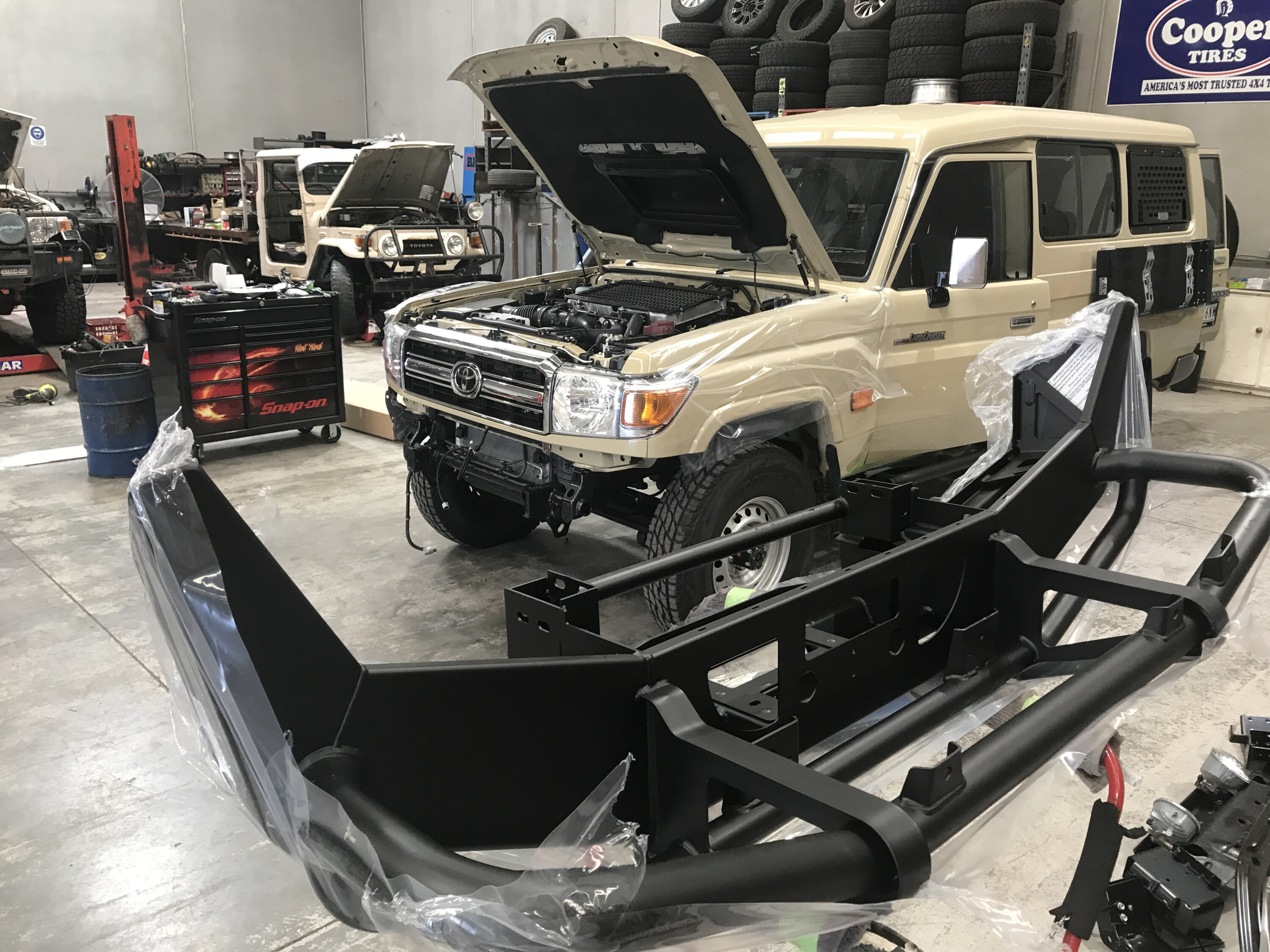
Fitting a bull bar is not as straightforward as it once was. As well as having to consider winch fitment, airbag compatibility and inbuilt LED lighting, even the 70 Series now comes with forward-facing radar as standard, adding to the complexity of bull bar fitment. As a result, the list of extra parts required has also lengthened, and includes a wiring extension harness for the radar unit and a wiring extension kit for the winch, to name just two.
We opted to fit a Carbon Tank 12,000lb electric winch for a number of reasons. Firstly, it weighs less than most other 12,000lb winches, and secondly, my son Trent has been using one for the past 12 months while leading expeditions for Moon Tours and he swears by it. We’ll bring you a full report once we have put this unit through its paces in the back blocks of Australia.
As well as the bar itself, we fitted a set of ARB side rails and side steps, and these are about the only things that don’t require an electrical wiring harness or an additional ECU to be added. I’ve run ARB side steps on all of my vehicles since 1988 (at least) and I wouldn’t drive my vehicles off-road without the protection they add.
Down the rear end of the Troopy we fitted for a Kaymar rear-step towbar. Over the years I’ve run three Kaymar rear bars, one on an earlier Troopy and a couple on my GU Patrols. The Kaymar rear bar is impressive and I can’t fault it for strength and reliability. The machining processes have improved over the years and while not so obvious with the 70 Series bars, Kaymar’s bars for 200 and 300 Series Cruisers are more appealing to the eye than they once were, and they blend harmoniously with the vehicles to which they’re fitted.
We’ve added a couple of swing-away spare-wheel carriers and a high-mounted work light to the rear bar, the latter for those evenings in the bush when we’ll need some extra lighting to carry out repairs or just to cook an evening meal. While I opted for the twin spare-wheel carriers, you can also choose to fit a double jerry can holder instead of the left-side wheel carrier for those times you are travelling long distances between fuel stops, or when you want to carry a bit more water.
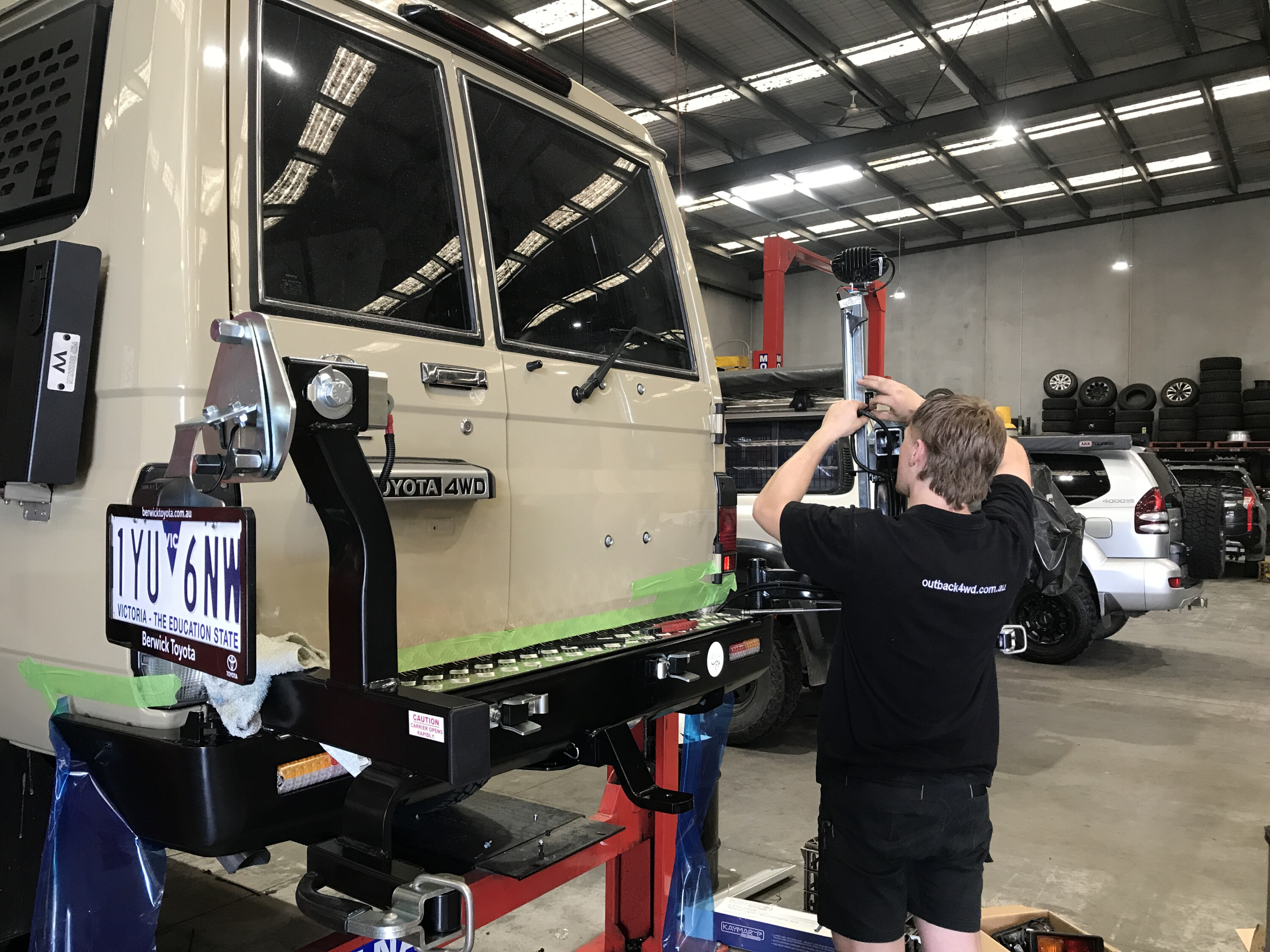
Kaymar bars are now available with auxiliary reversing sensors, which locate four sensors in the bar with a warning buzzer under the dash. We went with this option and although we wondered if it would be more of an annoyance than anything else, it has proven to be beneficial, especially when reversing into a tight parking space. It also makes it safer to reverse when people, especially kids, are around.
The power for the sensors is picked up off the vehicle’s reversing light wire, and while the control box can be located basically anywhere it will fit thanks to long leads, the warning buzzer needs to be positioned under or close to the dash. In addition to the wiring for the reversing sensors, the LED lights in the bar need a resistor box so they will work correctly.
When wiring in the trailer plug for our camper, we added a Redarc Tow-Pro Elite brake controller, which I reckon is the bees knees of brake controllers for any 4×4 vehicle. And, we’ve also added an Anderson plug outlet for when the camper is on the back of the Troopy, to help keep its batteries charged and the fridge cold.
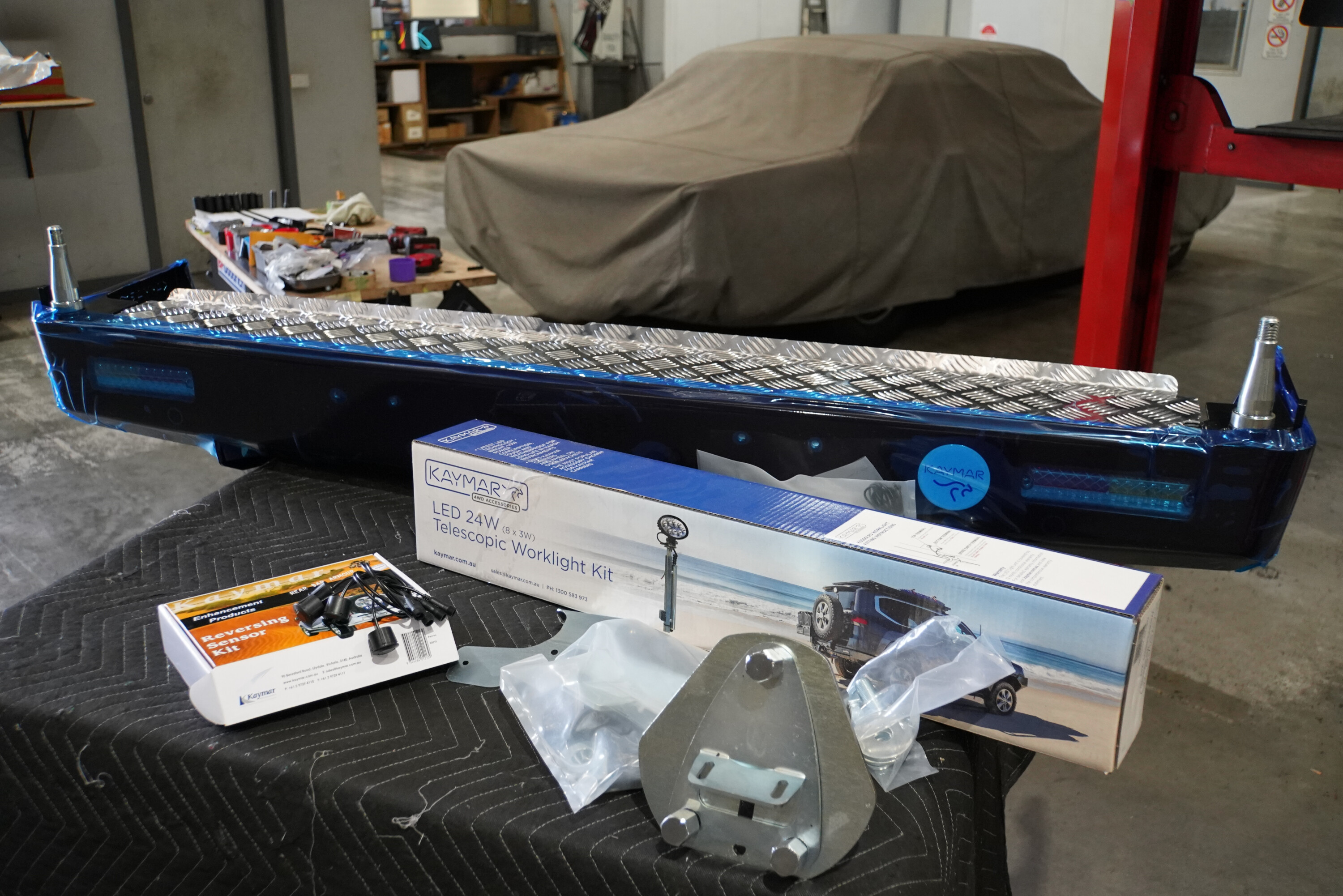
Fitting the bulbar, winch, rear-step bar and tyre carriers demands a lot more equipment, time and expertise than what most people have at home, and I never fail to be surprised at how much electrical work is required these days for fitting just about anything. Luckily the crew at Outback 4WD know what they are doing and have plenty of experience in fitting equipment like this.
While I’ve been taking my vehicles to Outback 4WD for years, wherever you are, make sure you have a good 4×4 workshop as your backstop for all accessory fitting, repairs and servicing.
Pricing
- ARB bull bar: $2285
- ARB side rails and steps: $1662
- Carbon Tank 12,000lb winch: $1499
- Kaymar rear step towbar: $2507
- Kaymar wheel carriers: $997 each
- Kaymar rear sensors: $225
- Kaymar work light: $344
- Redarc brake controller kit: $593
More info
- Kaymar: kaymar.com.au
- Redarc: redarcelectronics.com
- Outback 4WD: outback4wd.com.au
- ARB: arb.com.au
- Carbon Offroad: carbonoffroad.com.au
Mazda has updated its 2024 BT-50 line-up by introducing a raft of features – including the addition of a Rough Terrain Mode for all 4×4 models – and debuting a new dual-cab chassis GT variant.
The GT model, previously only available in dual-cab pick-up guise, will now be available with a dual-cab chassis layout for the first time. Sitting above the XTR in the model hierarchy, the GT is a more premium offering. It utilises the LED headlamps, dual-zone climate control, nine-inch touchscreen and leather-bound steering wheel and gear knob as found in the XTR, but it adds a remote start function (operable via the key fob), chrome-finished heated exterior mirrors, heated front seats and brown leather seat trim.
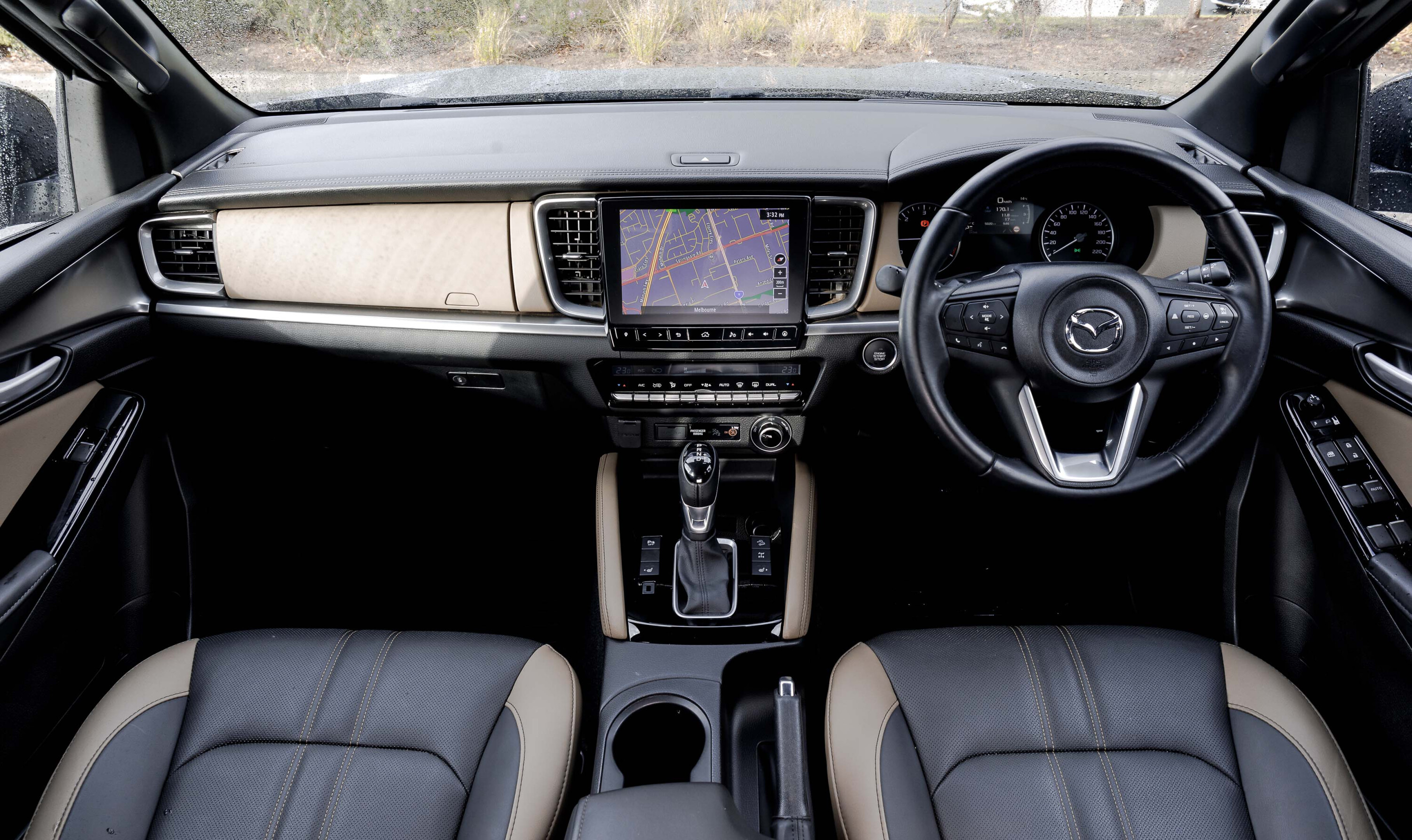
“Our comprehensively specified GT model grade brings with it a number of welcome extras that provide added comfort and refinement for the driver and occupants, while the ‘blank canvas’ of the cab-chassis opens up endless options for customisation at the rear,” said Vinesh Bhindi, Managing Director of Mazda Australia. “Putting the two together gives our customers yet another opportunity to fulfil their favourite pursuits.”
The addition of a Rough Terrain Mode on all 4×4 models headlines the changes across the line-up. The mode, activated by pressing a separate button located next to the gear shifter, modulates throttle and brake inputs and intervenes before wheel spin can occur, to instantly transfer torque to the wheels with most traction. It’s a great tool to optimise traction control when off-road.
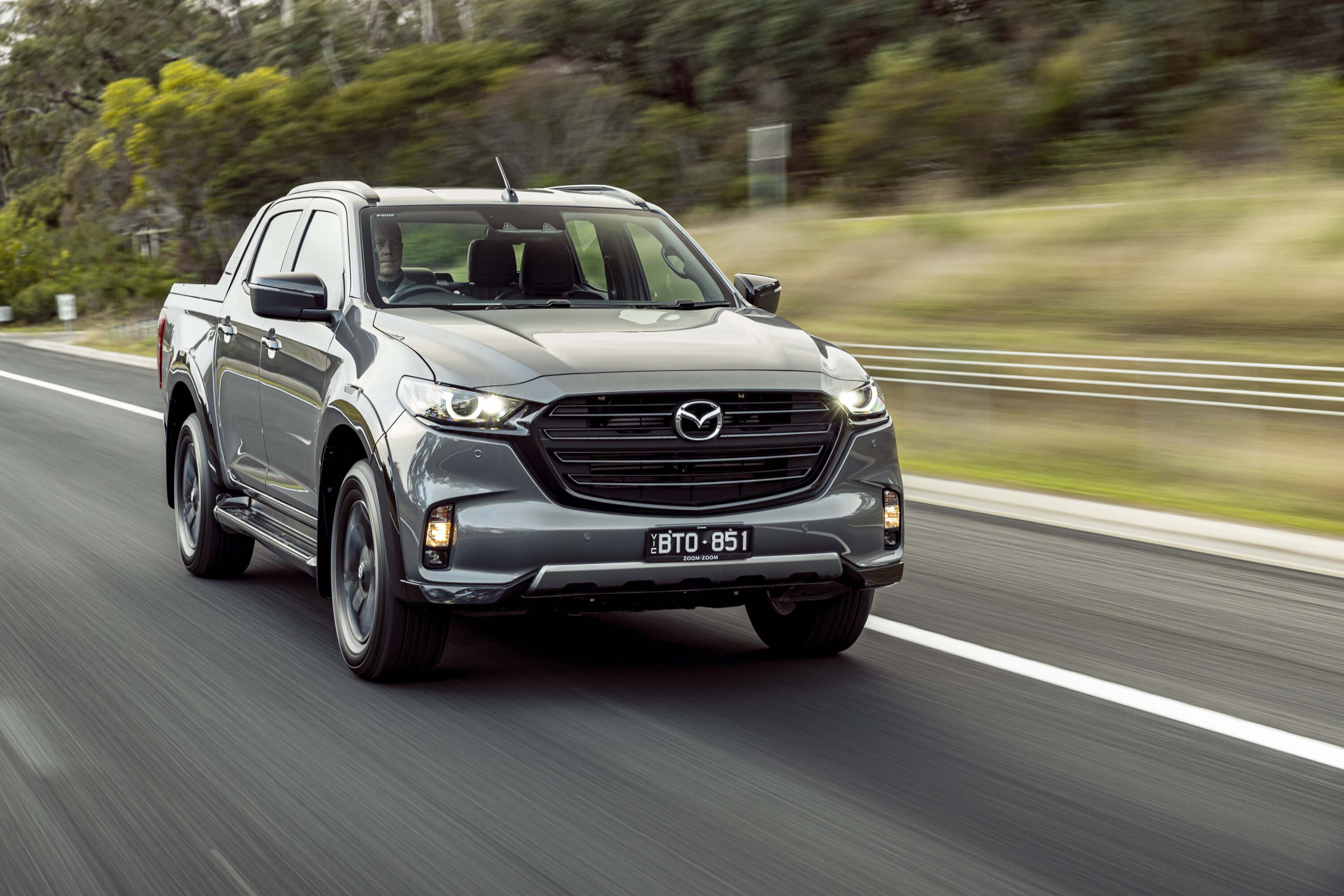
Another change for XTR models and above is the ability for accessories to remain powered after the engine has been shut-off; while lower-spec XS and XT variants have gained auto relock functionality, which is already standard on XTR models and above.
Pricing remains unchanged across the board, with only the BT-50 SP increasing by a lowly $30. The updated 2024 range is available to order now, backed by a five-year, unlimited-kilometre warranty.
Pricing
| Model | MLP |
|---|---|
| 1.9L Single Chassis XS 4×2 | $ 35,520 |
| 3.0L Single Chassis XT 4×2 | $ 38,520 |
| 3.0L Freestyle Chassis XT 4×2 | $ 42,020 |
| 3.0L Dual Cab Chassis XT 4×2 | $ 46,060 |
| 3.0L Dual Cab Pickup XT 4×2 | $ 47,460 |
| 3.0L Dual Cab Pickup XTR 4×2 | $ 51,540 |
| 3.0L Single Chassis XT 4×4 | $ 43,520 |
| 3.0L Single Chassis XT 4×4 | $ 46,020 |
| 3.0L Freestyle Chassis XT 4×4 | $ 47,020 |
| 3.0L Freestyle Chassis XT 4×4 | $ 49,520 |
| 3.0L Dual Cab Chassis XT 4×4 | $ 51,330 |
| 3.0L Dual Cab Chassis XT 4×4 | $ 53,830 |
| 3.0L Dual Cab Chassis XTR 4×4 | $ 57,880 |
| 3.0L Dual Cab Chassis GT 4×4 | $ 61,260 |
| 3.0L Dual Cab Pickup XT 4×4 | $ 52,730 |
| 3.0L Dual Cab Pickup XT 4×4 | $ 55,230 |
| 3.0L Dual Cab Pickup XTR 4×4 | $ 56,780 |
| 3.0L Dual Cab Pickup XTR 4×4 | $ 59,280 |
| 3.0L Dual Cab Pickup GT 4×4 | $ 62,660 |
| 3.0L Dual Cab Pickup SP 4×4 | $ 68,690 |
| 3.0L Dual Cab Pickup Thunder 4×4 | $ 74,095 |
With a growing appetite for technology, the need for portable power when away from the bright lights of major cities has never been stronger.
Sure, some of us prefer to escape the rat race to sit beneath the stars in peace and quiet. However, portable power can be of benefit to these people, too. Portable power can keep gear charged so you can snap photos, find your way around with a GPS, make camp cooking a lot easier, stay connected to the world back home, and keep the little ones entertained.
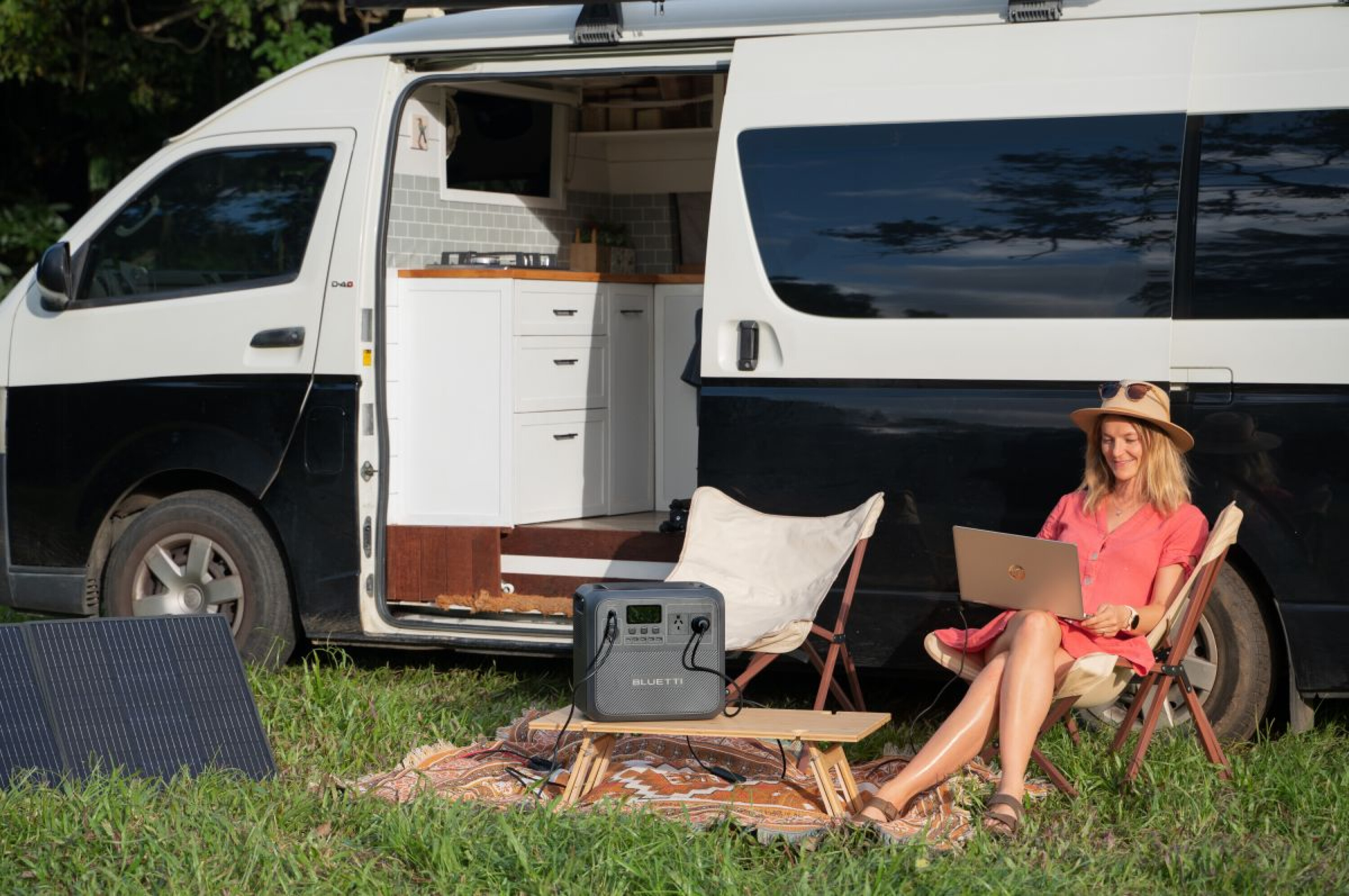
The tech has come a long way, too. With lighter batteries and state-of-the-art solar panels and power stations now on the scene, you can keep gear powered without hauling around a tonne of weight.
Don’t forget the allure of getting off the beaten track. With more and more folks exploring the bush, access to portable power provides peace of mind and contact with those back home. It’s beneficial in a safety sense, too, by keeping comms charged and ready in case of an emergency when you’re out in the middle of nowhere.
Remember, a vehicle’s starting battery is designed to fire up your vehicle’s engine, not to power your fridge, light up your campsite, run a laptop and charge your camera batteries. For these tasks you’ll need an additional power source.
Here’s everything you need to know about portable power.
JUMP AHEAD
- Portable power stations
- Portable power packs
- Generators
- Solar panels
- Dual battery systems
- Smart battery box
Portable power stations
A portable power station is essentially a compact, mobile power source you can pack in the back of a 4×4 for electricity on the fly. It’s ideal for camping trips, off-road adventures, or even to handle power failure at home.
The stations typically feature a rechargeable battery pack and a variety of power outlets, including AC sockets, DC ports, and USB ports. Some models even come equipped with built-in inverters to convert stored energy into usable AC power. They come in different sizes and capacities, ranging from pocket-friendly units to larger ones resembling compact suitcases.
They’re versatile units that are capable of powering a wide array of devices, from smartphones and laptops to small appliances like mini fridges or power tools. They can be recharged using solar panels, standard power outlets and car chargers, making them ideal for off-grid adventures.
Portable power packs
A portable power pack – also referred to as a portable charger or power bank – is a compact device with a built-in battery designed to recharge electronic gadgets when a power outlet is beyond reach.
A power pack essentially acts as a mobile battery you can carry with you to provide emergency power whenever your devices run low on battery. They come in a variety of sizes and capacities and they typically feature one or more USB ports. Some models may even include features like built-in cables, LED indicators to show battery level, fast-charging capabilities, and wireless charging pads.
Most portable power packs will offer charging via a 240V mains source, 12V DC or Anderson plug (for solar panel input), and have outputs including 12V accessory plugs, USB ports and merit sockets. Other features will include a voltage/amperage display, low battery warning (light and alarm) and overload protection. There are power packs on the market ranging from 33Ah capacity to over 100Ah.
Portable power packs are rechargeable and can be charged using USB ports, wall adapters and solar panels, and they’re incredibly useful for who anyone who travels off-grid.
Generators
A generator serves as a portable power supply for off-road lifestyles such as camping and 4x4ing. To make them easy to transport and ideal for remote areas, camping generators are typically compact and lightweight.
Powered by various fuel sources including petrol, gas, diesel or even renewable energy like solar power, these generators come in various sizes and power capacities, ranging from smaller models suitable for charging phones to larger units capable of powering caravans, campsite lighting, or even fridges and air conditioners.
The units feature multiple outlets including AC sockets, DC ports, and USB ports, and they allow users to power a variety of devices simultaneously. Some models are more fuel efficient than others, with lower emissions and an automatic shutdown function to prevent overload or low fuel issues.
With generators, it’s essential to consider factors like noise levels, fuel efficiency and environmental impact.
Solar panels
Whether you opt for a solar panel affixed to the roof of your vehicle or trailer, a fold-out panel that you can set up on a stand, or a solar blanket you can lay across the bonnet or windscreen, you’ll need to ensure it has enough output to meet your power requirements.
You’ll also need to make sure it’s equipped with a regulator to safely charge your vehicle’s battery, smart battery box or power pack, and that it comes with a cable long enough to reach your battery’s charging input.
A solar panel is a portable device that captures sunlight to generate electricity for powering electronic devices or charging batteries. Lightweight and available in various sizes, these panels consist of photovoltaic cells encased in durable, weather-resistant materials.
They offer a renewable and environmentally-friendly power source, particularly useful in remote areas. Silent, emission-free, and low-maintenance, they’re well-suited for outdoor use. Considerations when selecting a solar panel include size, weight, power output, durability and compatibility with charging devices or portable power stations, to ensure optimal performance during camping trips.
Dual battery systems
Dual battery systems have been around for a long time and they’re still one of the most popular solutions for powering electrical equipment when you’re enjoying an off-road adventure.
The components of a dual battery system are the vehicle’s charging system (alternator), the starting battery, an auxiliary battery (usually a deep-cycle battery), a battery tray or battery box, a wiring loom and a battery isolator.
While starting batteries are designed to deliver short bursts of power for starting the vehicle’s engine, deep-cycle batteries are designed to discharge more slowly over a longer period of time to power accessories.
There are several types of deep-cycle batteries including Absorbed Glass Mat (AGM), Gel batteries and lithium iron phosphate (LiFePO4) batteries, the latter the most expensive option but advantageous due to compact dimensions, lighter weight and longer service life (up to 10 times).
The battery tray or box is designed to securely hold the battery in place, either in the engine bay (if there’s space), under the vehicle or in the tray/tub of a ute.
As its name suggests, the battery isolator simply isolates the starting battery so that electrical appliances run off the auxiliary battery, ensuring the starting battery always has enough charge to fire up the engine. Isolator types can include a manually operated switch, a switching solenoid, a blocking diode or a microprocessor control system.
Modern vehicles, with ‘smart’ alternators, require the inclusion of a DC to DC charger in the dual battery system to ensure correct battery charging.
The cost of a dual-battery system will vary depending on several factors, but when you add up the cost of all components plus labour for installation, you’ll be looking at a minimum of around $1000, and significantly more if you add a DC to DC charger to the set-up and/or you fit an expensive LiFePO4 battery.
Smart battery boxes
If your vehicle doesn’t have space for a traditional dual battery system, or you simply want a set-up you can transfer from vehicle to vehicle, a smart battery box is a very good alternative.
These boxes are designed to accept a variety of battery types and they can be hardwired to the vehicle’s electrical system or, in some cases, plugged in to a 12V power outlet. Some can also be charged from a 240V mains source; others feature external battery terminals for charging, as well as Anderson plug inputs for charging via solar panels.
Smart battery boxes offer a combination of power outlets including USB ports, 12V DC ports and, if fitted with a built-in inverter, 240V AC outlets. Some also incorporate a smart DC to DC charger, power management display, and a low-voltage cut-out to prevent accidental drainage of the starting battery.
There is nothing worse than arriving at your favourite destination to find that your auxiliary battery is dead on arrival, just when you need it most. The Projecta INTELLI-IQ Smart Display (IQD2) makes this horrible situation a thing of the past.
IQD2 is the communication hub for the Projecta DC system, enabling users to create a smart home on wheels by providing complete control of the DC System, including charge rate and battery voltage. IQD2 is the first of five phases of the Projecta Internet of Things (IoT) System, and it ensures both scalability and allows the integration of future products and technologies.
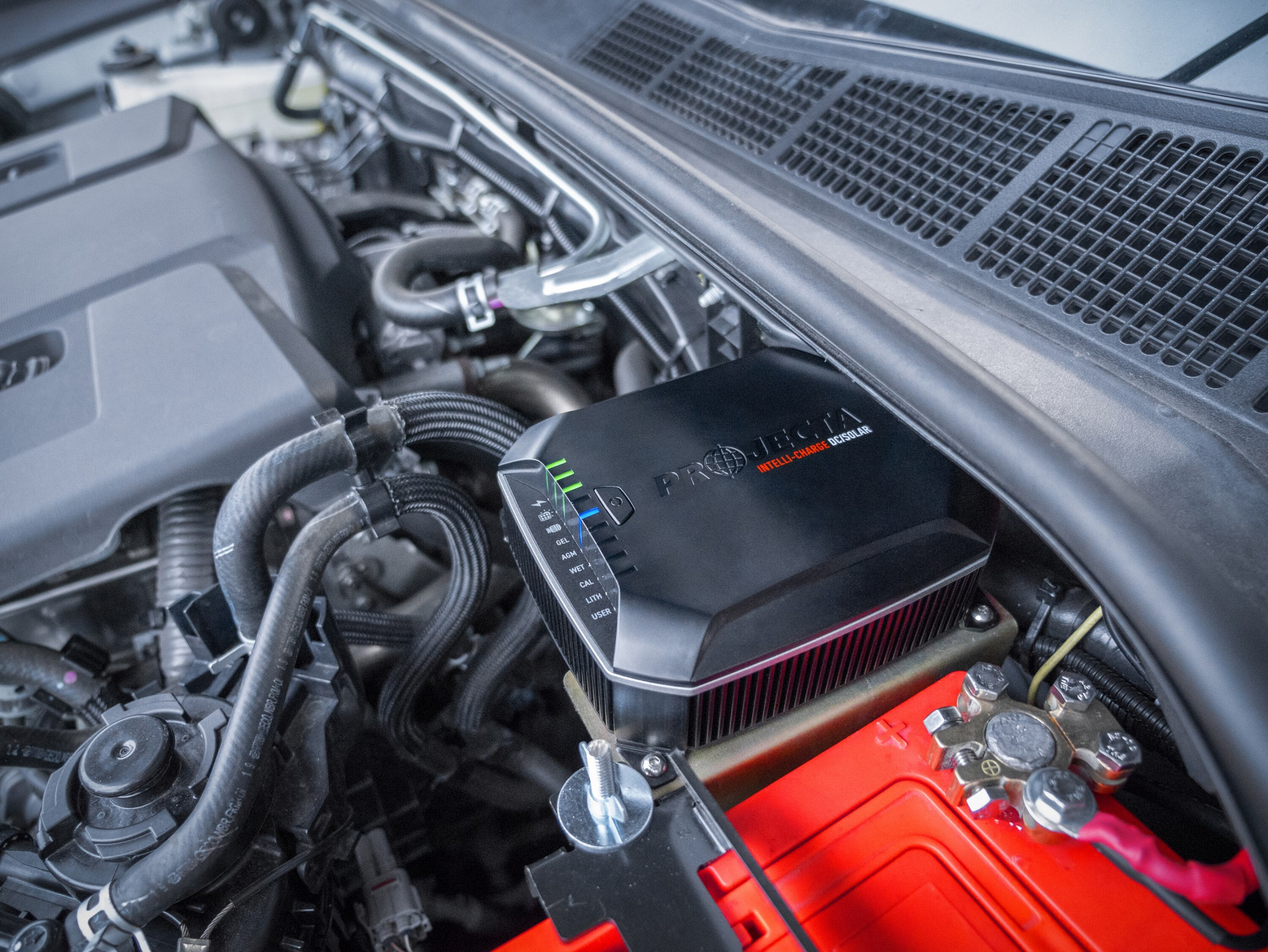
Projecta’s IQD2 links connected products within the Projecta network, providing a new way of connecting and controlling devices without being physically hardwired or relying on Bluetooth. Think of the unit as being the ‘brain’ in a portable smart system, giving you total and reliable control over your auxiliary 12V equipment. With this functionality, you will never turn up at a campsite with a flat battery and a warm fridge again.
Projecta Senior Brand Manager, James Pearson, said the new INTELLI-IQ Smart Display unlocked the full potential of the IDC25X DC to DC charger and other Projecta equipment.
“When paired with the IDC25X charger, the INTELLI-IQ Smart Display further elevates the charger by offering total and convenient control – in combination, the technology is unique and industry-leading for the segment,” he explained. “Many competitor systems feature Bluetooth control where the appliance connects directly to the smart device.
“These systems can be subject to functionality issues with range and connectivity; this is often because the appliance is mounted in the engine bay or another area shielded by layers of metal, causing a barrier for the Bluetooth signal. In comparison, the IQD2 offers automotive grade communication meaning no dropouts along with an easy set-up,” Pearson added.
The INTELLI-IQ Smart Display unit features a two-inch display screen. It can be mounted anywhere you want due to the single-wire connectivity, and the cable is easy to manipulate around a 4WD. The unit itself can be mounted flush, at an angle, or even upside down.
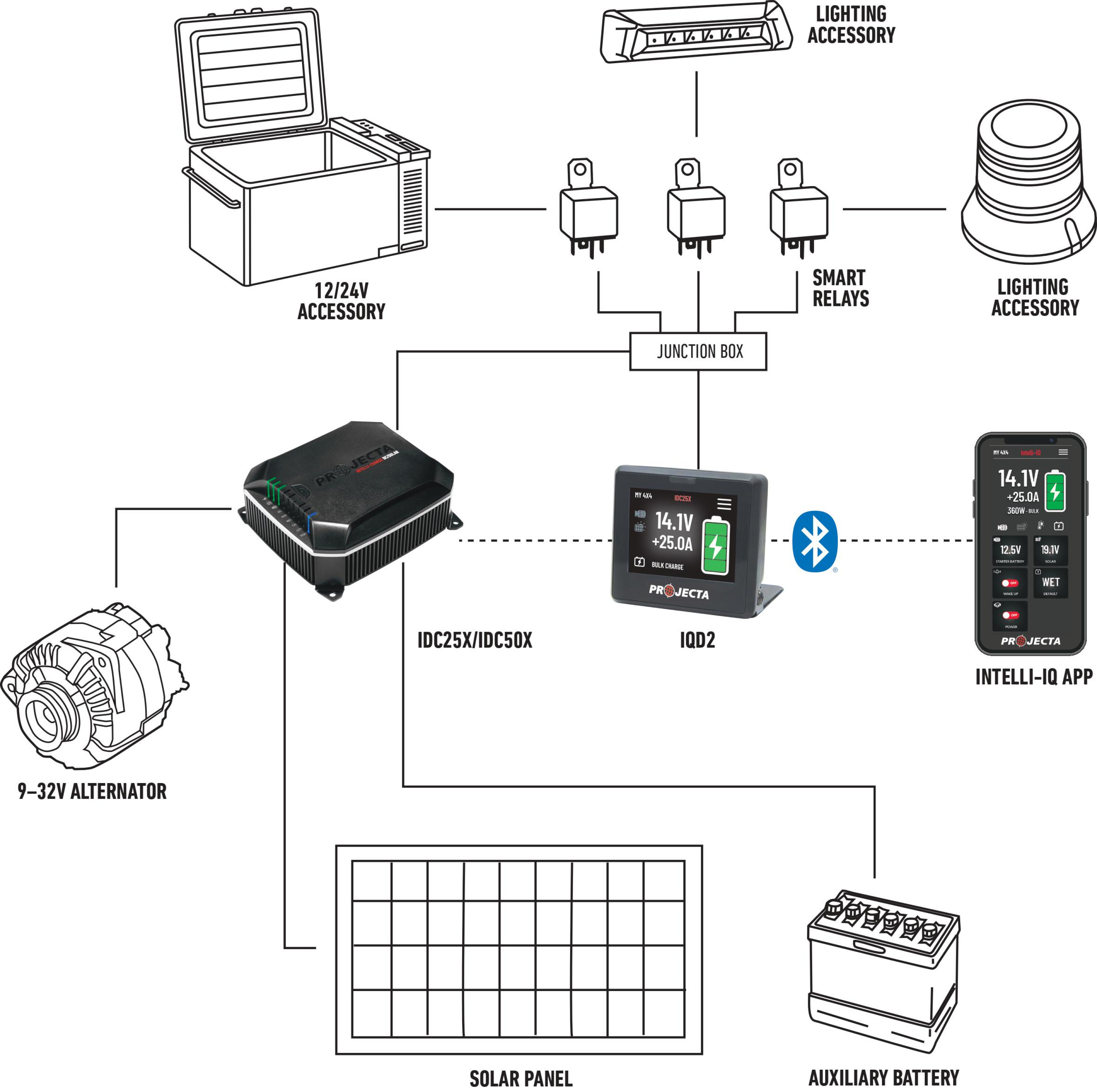
The screen features an ultra-wide display angle, a capacitive touch screen that supports ‘smooth touch’ with enhanced sensitivity, and swipe-to-change screens. Additionally, it includes automatic brightness adjustment and the ability to further customise settings using the INTELLI-IQ app. Through the app the user can monitor at some distance from the 4WD and program various alarms and notifications to be alerted before it is too late, meaning users should never experience the inconvenience of a flat battery.
The INTELL-IQ Smart Display can be purchased from leading automotive, caravan, camping and specialist battery/generator outlets Australia-wide, and is backed by a generous five-year warranty.
Big Red Gear’s new rechargeable LED camp lights are designed to offer greater convenience at the campsite, in the home, or for the car toolbox in case of emergency.
Included in this new range is an LED Mini Camp Light and an LED Head Torch, which both feature a high-powered COB LED that produces a crisp, bright white light. The Mini Camp Light offers four different modes depending on what you require – flood light full power; flood light normal; flood light eco; and spotlight – to make it an extremely versatile light.
Despite its compact size, the Mini Camp Light still delivers 700 lumens in full power mode and is capable of this output for 2.5 hours. Run time increases to 4.5 hours in normal mode and up to 10 hours in eco mode. When used in spotlight mode, the run time is four hours. Recharging time for Mini Camp Light is 4.5 hours via the included USB charging cable.
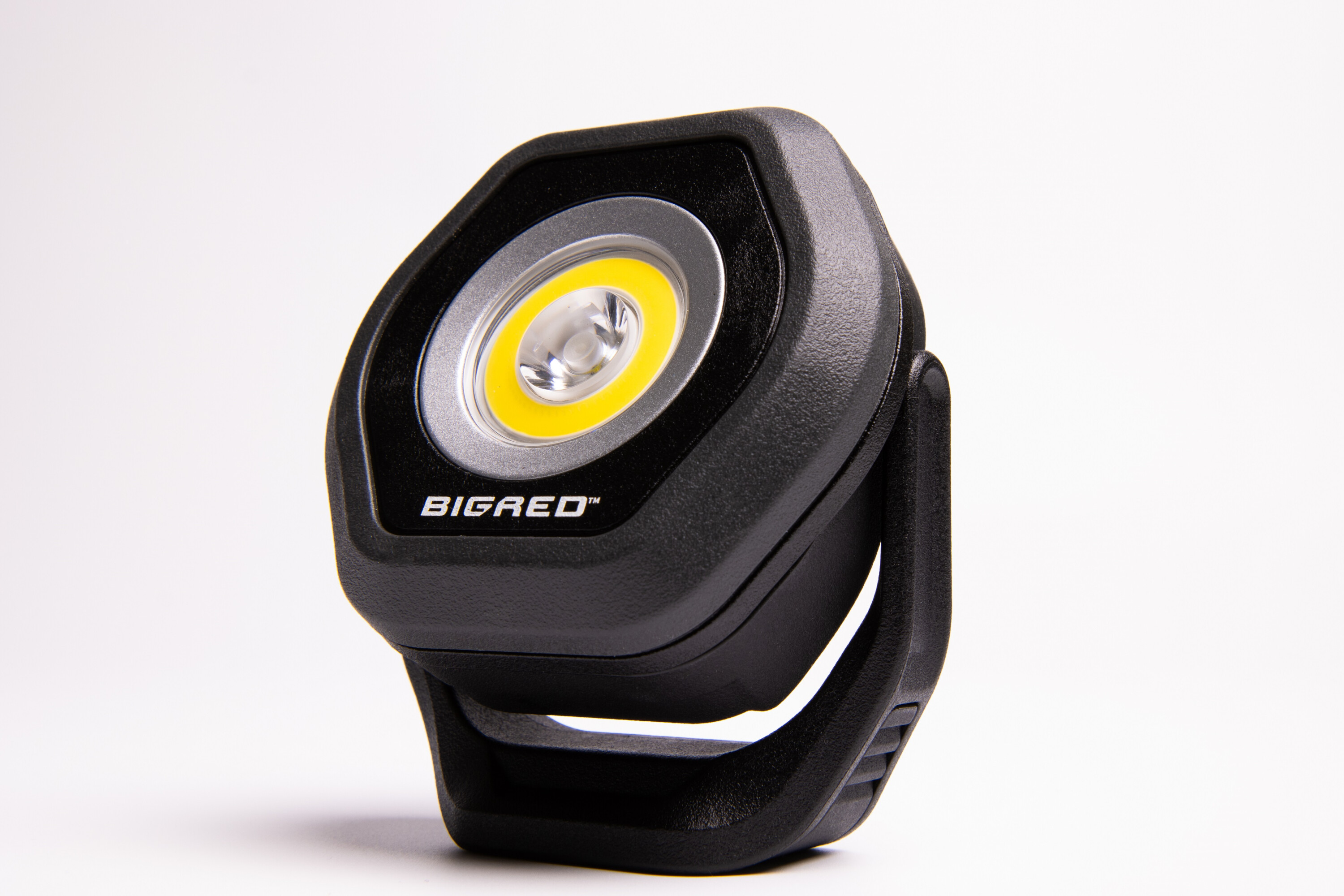
The adaptable Mini Camp Light also features a swivel bracket with 180 degrees of adjustability, as well as a magnet that allows it to be placed on the side of a vehicle or inside the engine bay. Another useful addition is the LED charge level indicator, so you can easily monitor the battery life.
If you need hands-free illumination – cooking by a campfire, taking a night hike or changing a tyre in the dark – the Big Red Gear LED Head Torch is a great choice with its three modes: normal output; full power output; and a convenient hands-free sensor mode. Full power mode provides 300 lumens of output for two hours; eco mode reduces output to 100 lumens but extends operating time to a substantial six hours; while sensor mode (where the torch is motion-activated such as when hands are dirty) provides two hours of light. Charging time for the Head Torch via the supplied USB cable is only 2.5 hours.
Senior Category Manager, Jake Smith, said the new LED camp lights provided convenience for a range of recreational pursuits and more.
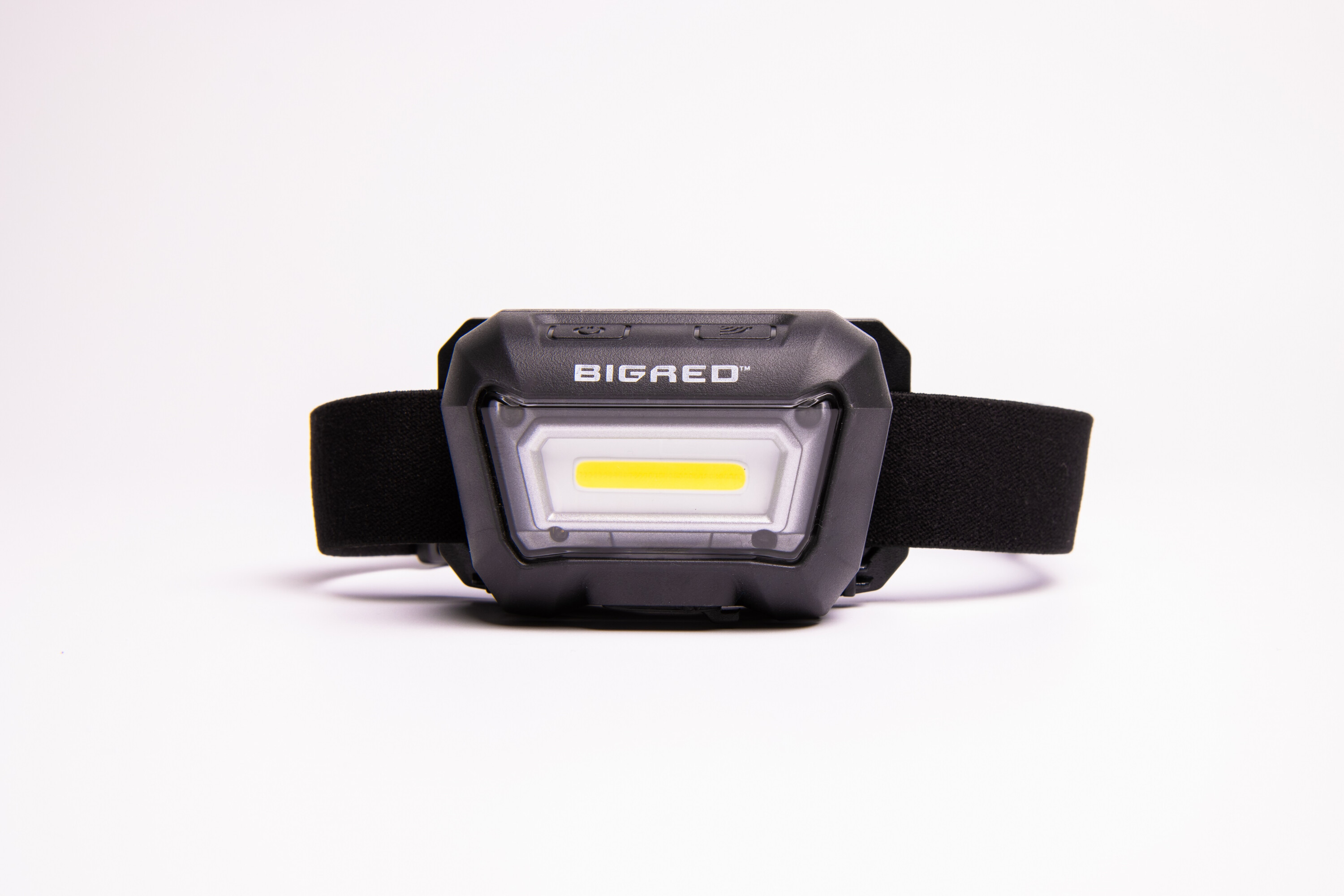
“These new LED camp lights from Big Red Gear offer a quality lighting solution when the sun goes down at the campground,” he said. “Owing to their compact size and generous light output, they’re also a worthy toolbox addition, or to have in the garage or home in the event of an emergency.”
Both LED lights are designed to provide reliable operation in temperatures ranging from minus 10° C to 40° C and are fully sealed and rated to IP65 and IK07 for dust and water ingress protection, making them suitable for Australia’s harsh conditions.
Pricing
The new Big Red Gear LED Mini Camp Light and LED Head Torch are available for purchase directly from the Big Red Gear website for $59 and $49 respectively, with shipping included. Both lights are backed by a three-year warranty.
Every dream career has its curses, right? Here’s mine: a photographer’s life is just as often a glorified pack-mule job.
Lugging gear is part and parcel of the gig, of course. Fragile lights, heavy lenses and camera bodies, battery packs, tripods and stands – and all the rest. So when I was asked to test drive the Isuzu MU-X LS-M for a few weeks, I was thrilled and confident it’d carry all my gear and more!
How did it perform as my daily automotive workhorse? Read on…
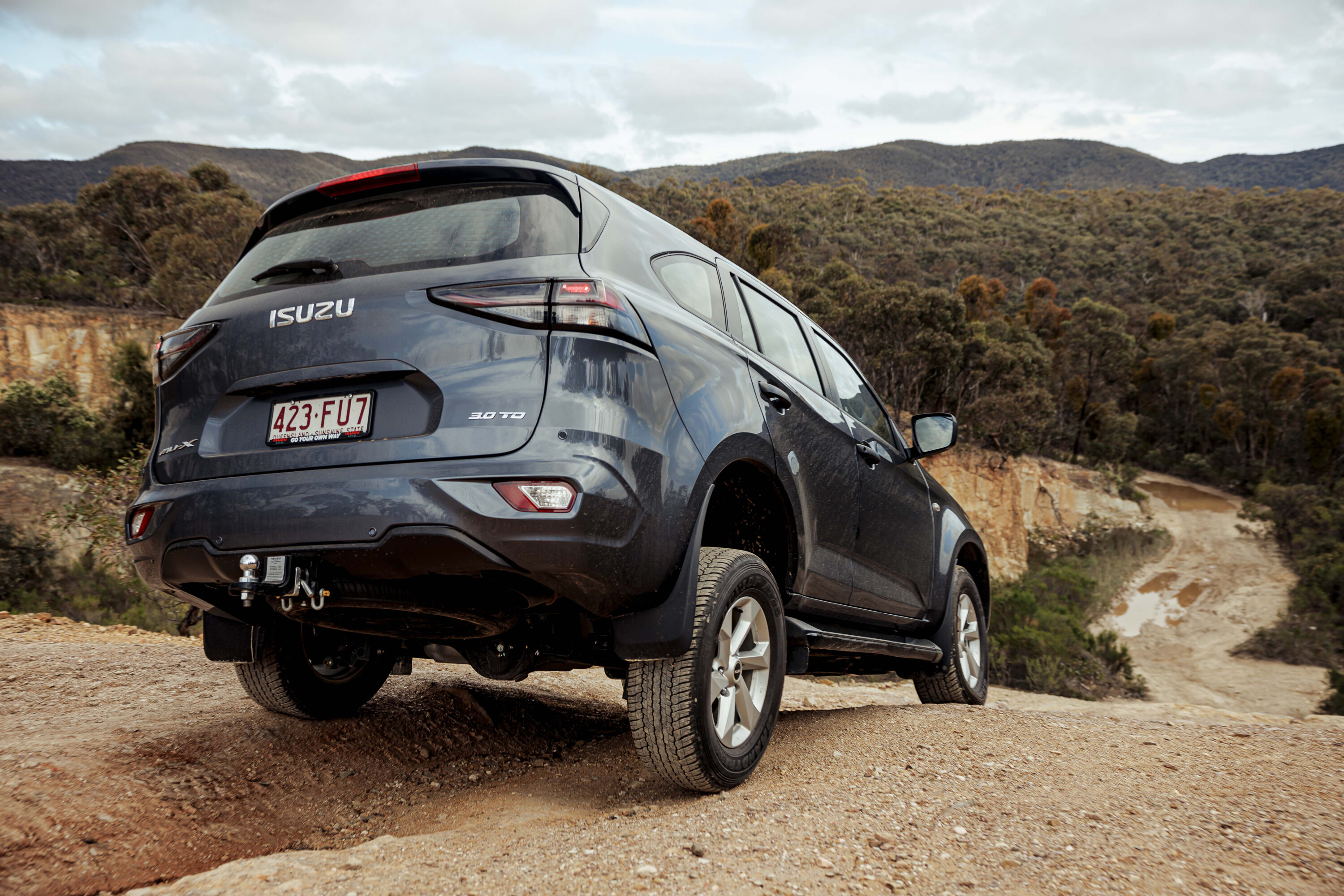
The car as tested
| 2023 MU-X LS-M, Obsidian Grey | |
|---|---|
| RRP | $54,900 |
| Tow bar kit | $1182.25 |
| 12-pin plug | $393.25 |
| Electronic brake controller | $896.05 |
| Rubber mats | $249.65 |
| Premium paint | $650 |
| Stamp duty on accessories | $136.06 |
| Total as tested | $62,731.27 |
JUMP AHEAD
- First impressions
- Comfort
- Technology & Entertainment
- On the road
- Safety features
- Fuel economy
- Last impressions
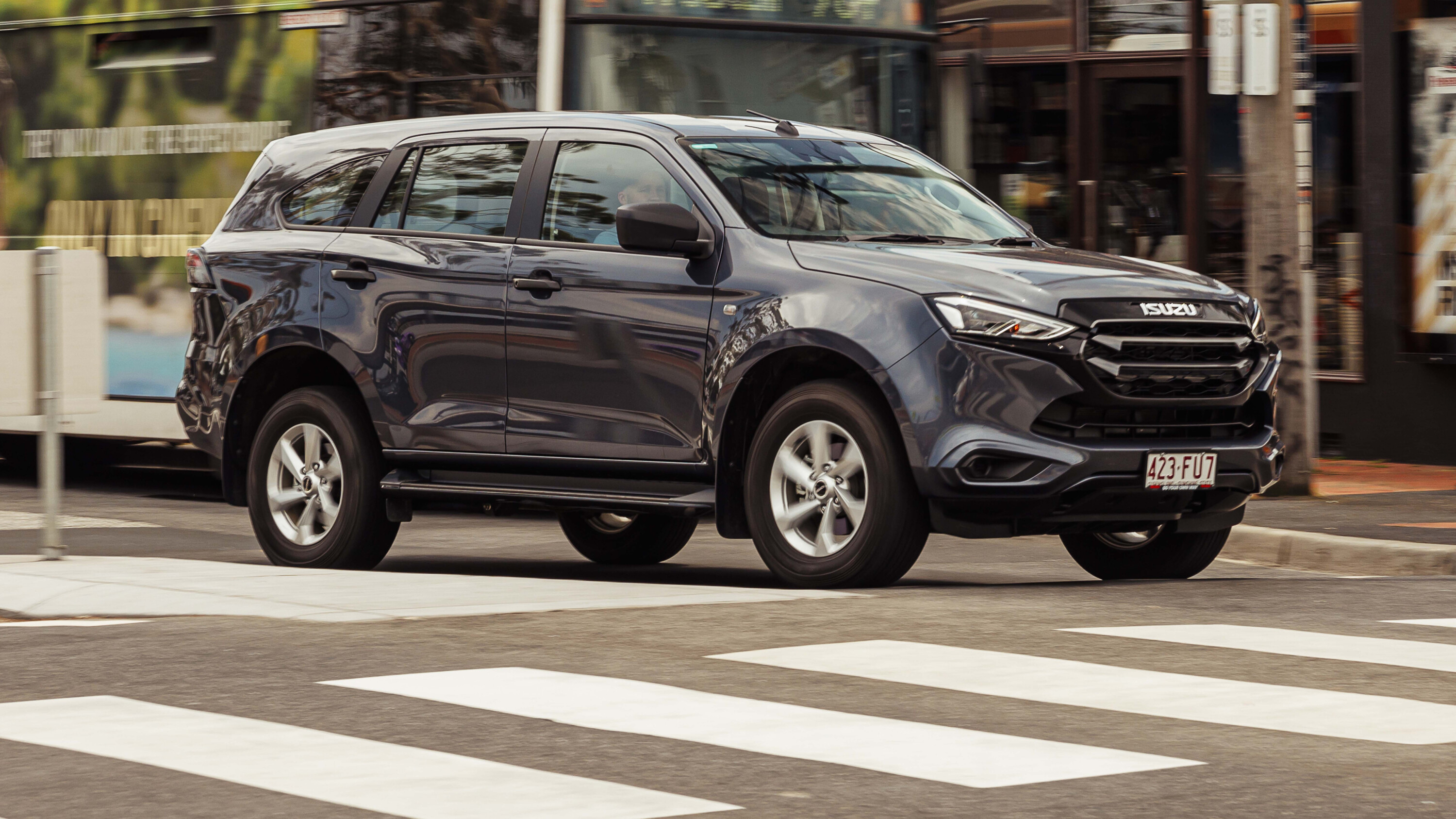
First impressions
Having spent the previous month in Izuzu’s 2023 D-MAX LS-U+, I immediately noticed the more family-oriented comfort of the MU-X LS-M.
I enjoyed the D-Max, but you can probably imagine that I prefer the extra security and internal space of the MU-X for my camera gear, camping kit and my newest family member – my puppy Cleo. Those needing extra seating for family, this seven-seater is your ride.
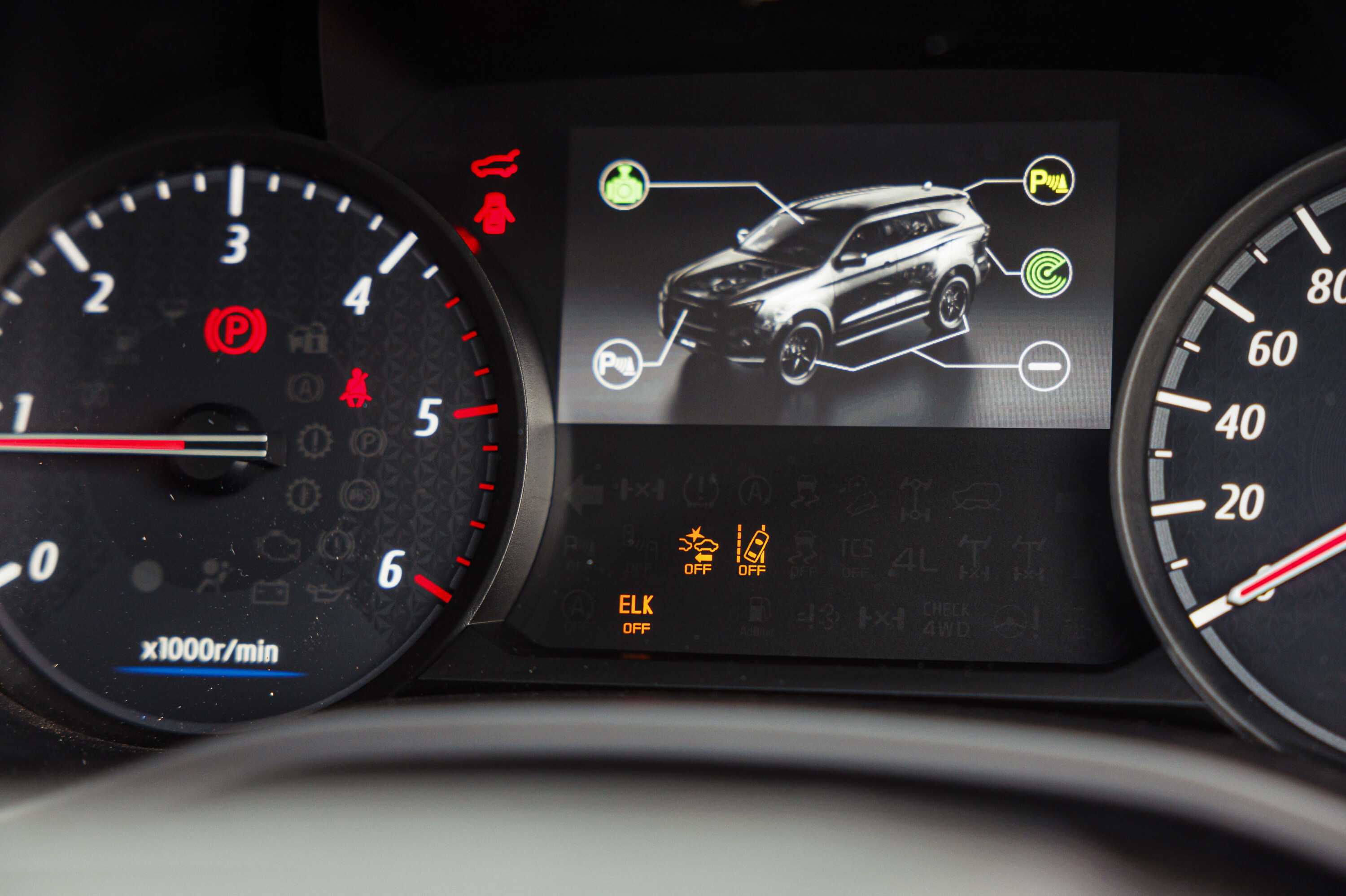
Comfort
The MU-X’s ride is clearly oriented towards passenger comfort, handling both on- and off-road action nicely.
The LS-M’s cloth seats meant no bare-skin leg burns on hot days. The seating adjustments with tilt and telescopic steering wheel movements give you great driver positioning, and the interior is very roomy for families.
At 5-foot-2, I tried the third-row seating: with a tumble-fold function of the middle seat, it’s easy to climb in and I’m confident most small–medium children would be comfortable, with ample head and wriggle room.
The boot is very generous, with more than enough room for plenty of gear. With the middle and rear rows folded, I could easily sleep in there on a stormy night away – skipping the swag!
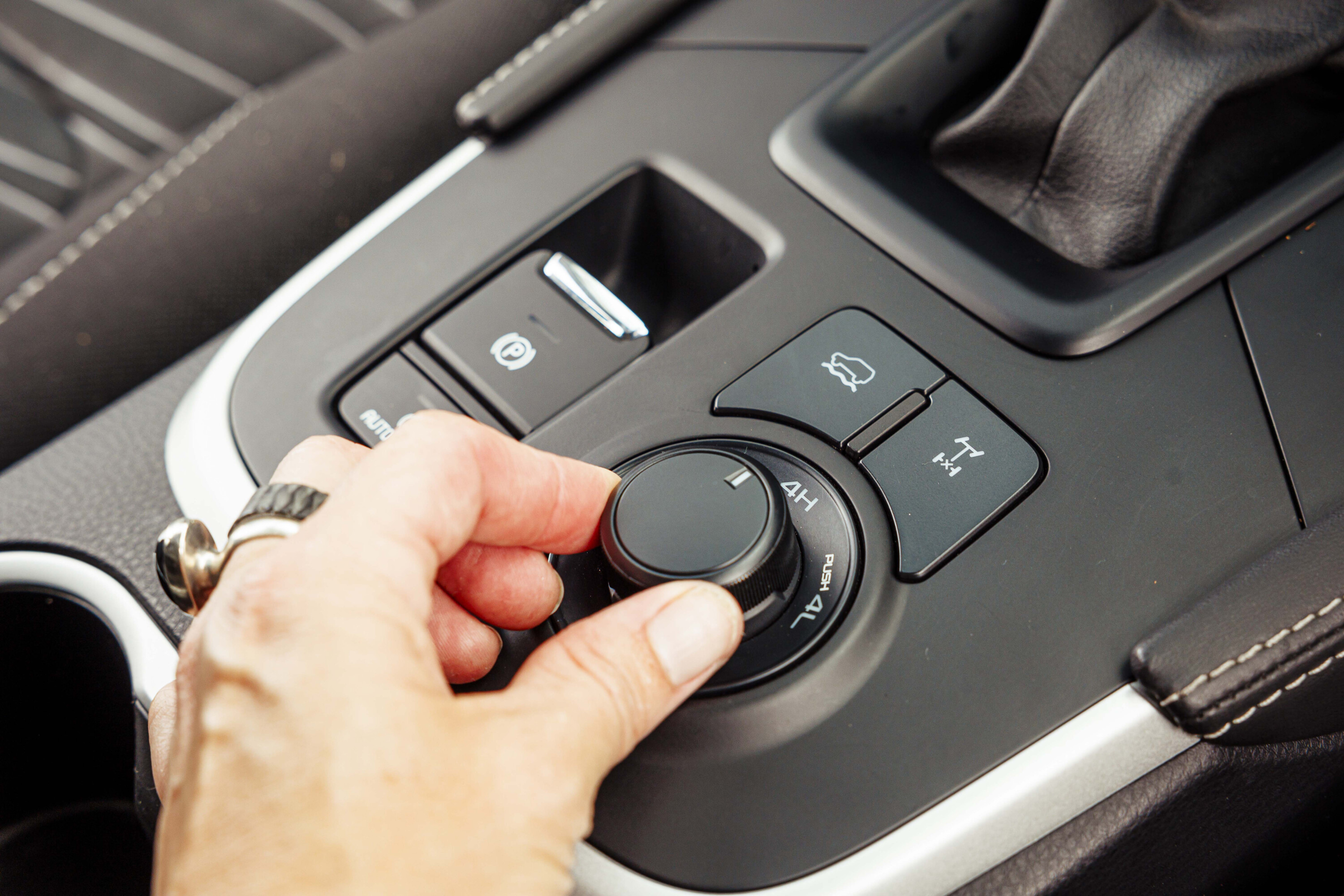
Technology & entertainment
As the entry-level model, the LS-M has a 7-inch display – which, by today’s standards and especially in a large SUV, feels small.
The display does at least have wireless Apple Carplay and wired Android Auto, although it’s missing the charge pad many of its rivals have. Still, wireless connectivity without wireless charging is a common combination across the market, as illogical as it might seem.
The MU-X only provides one USB port up front, however there are two USB ports in the middle row for keeping your travelling companions happy.
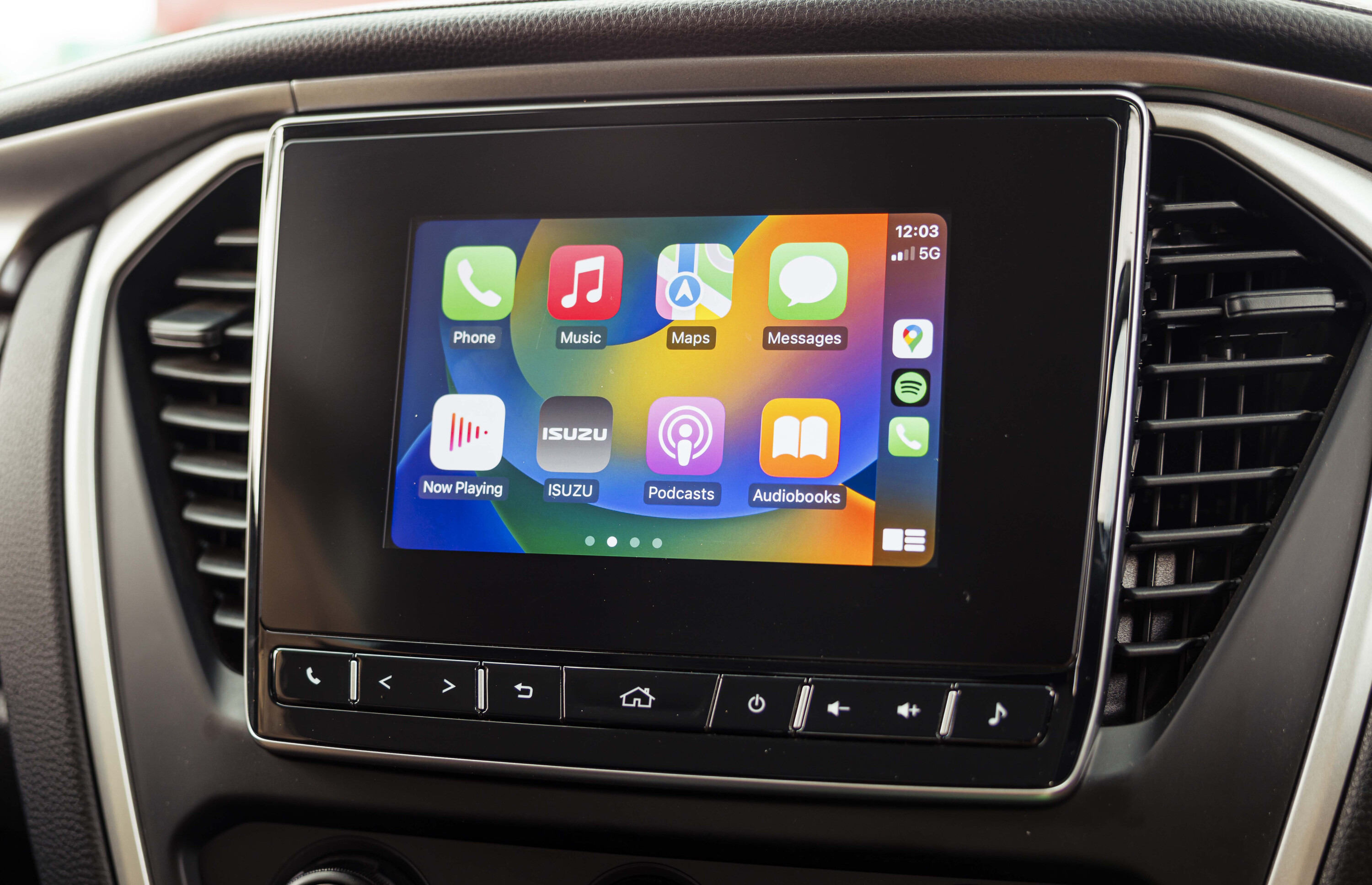
On the road (and off!)
Getting out of Melbourne with shoots in Bendigo and Swan Hill, before taking a quick couple of days out camping at a friend’s lagoon near Echuca.
I ran the MU-X through the varied gravel and dirt terrain, and its steering and traction all felt responsive and secure. Its highway ride, likewise, is great, especially with reliable adaptive cruise control. The safety lane assist takes some getting used to, however, being quite sensitive at times.
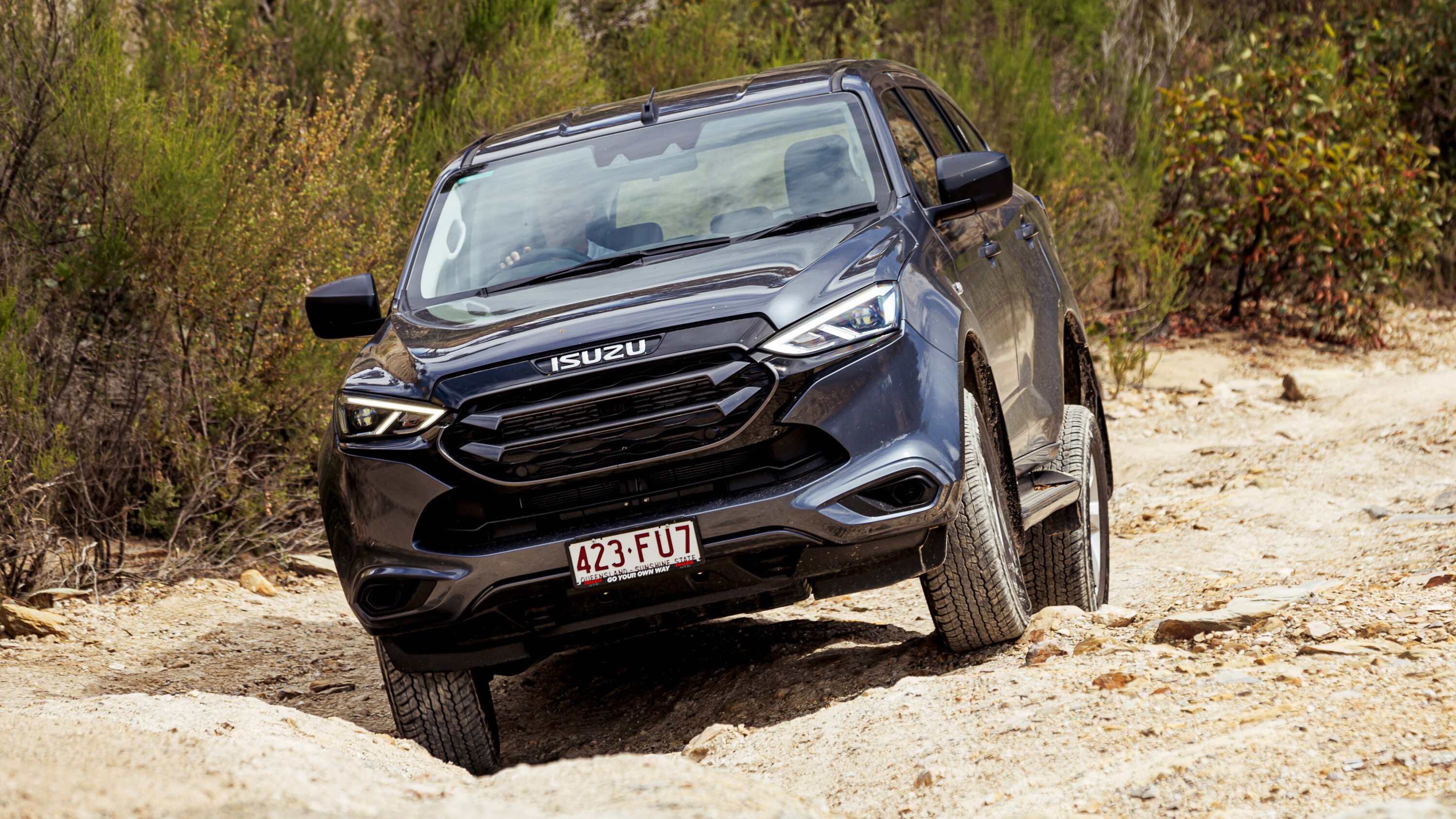
While I didn’t do anything too challenging, the MU-X’s varied drive options meant it held its own on simple off-road and light articulation, with 17-inch wheels and all-terrain tyres being practical for unsealed exploring.
Up next was a photo shoot in Lerderderg State Park with pup Cleo on board, on her first off-road journey. I tried a few easier articulated tracks, and it handled them well. (As did Cleo!)
Like most standard 4x4s, the MU-X’s clearance, tyre pressure and tread for larger and more challenging tracks would be something to be mindful of, especially with slipping in wet weather conditions.
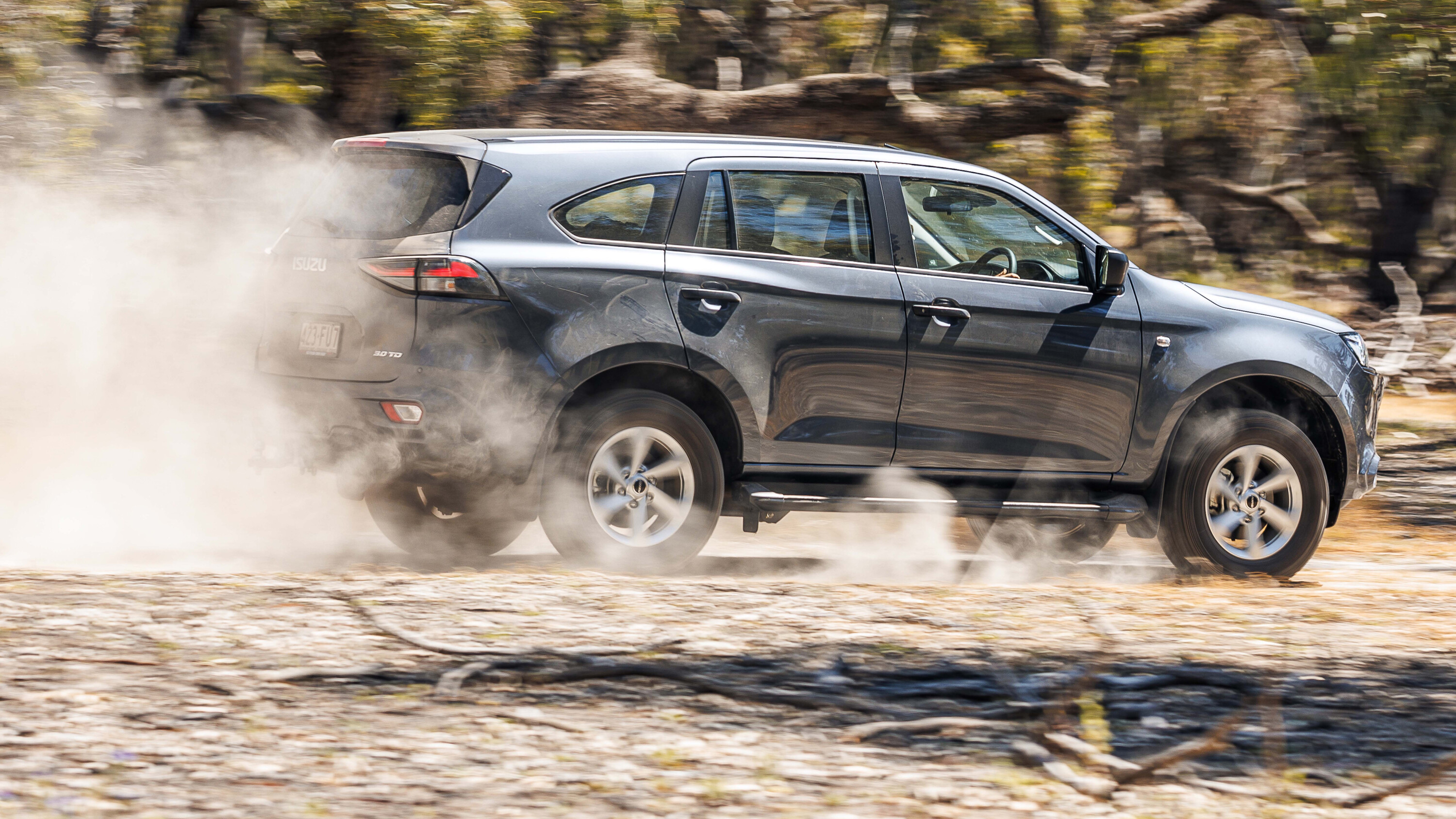
Safety features
The MU-X LS-M, whilst the base model, offers plenty of safety features that trumps some of its rivals.
These include a 5-star ANCAP rating (tested in 2021), excellent adaptive cruise control, AEB and lane assist. The front and rear parking sensors are particularly handy in inner city parking situations, given the size of the MU-X and my own diminutive height.
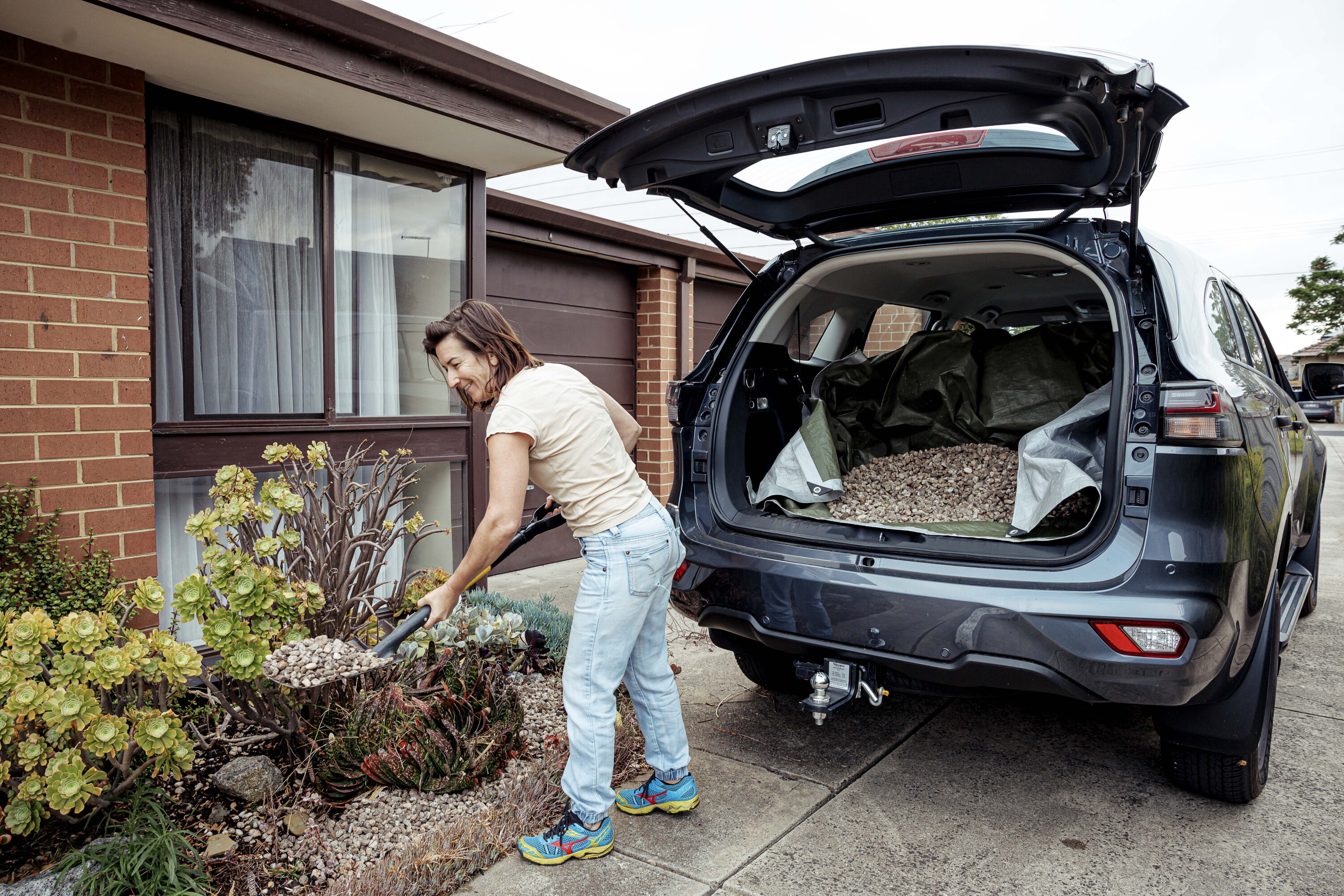
Fuel economy
I put the MU-X through a variety of jobs, from long highway runs to some short local shopping trips around town.
With the off-roading, the average fuel numbers came in at 8.4 to 8.8 litres per 100km – making it a lot more efficient than my usual daily, a petrol-loving FJ cruiser.
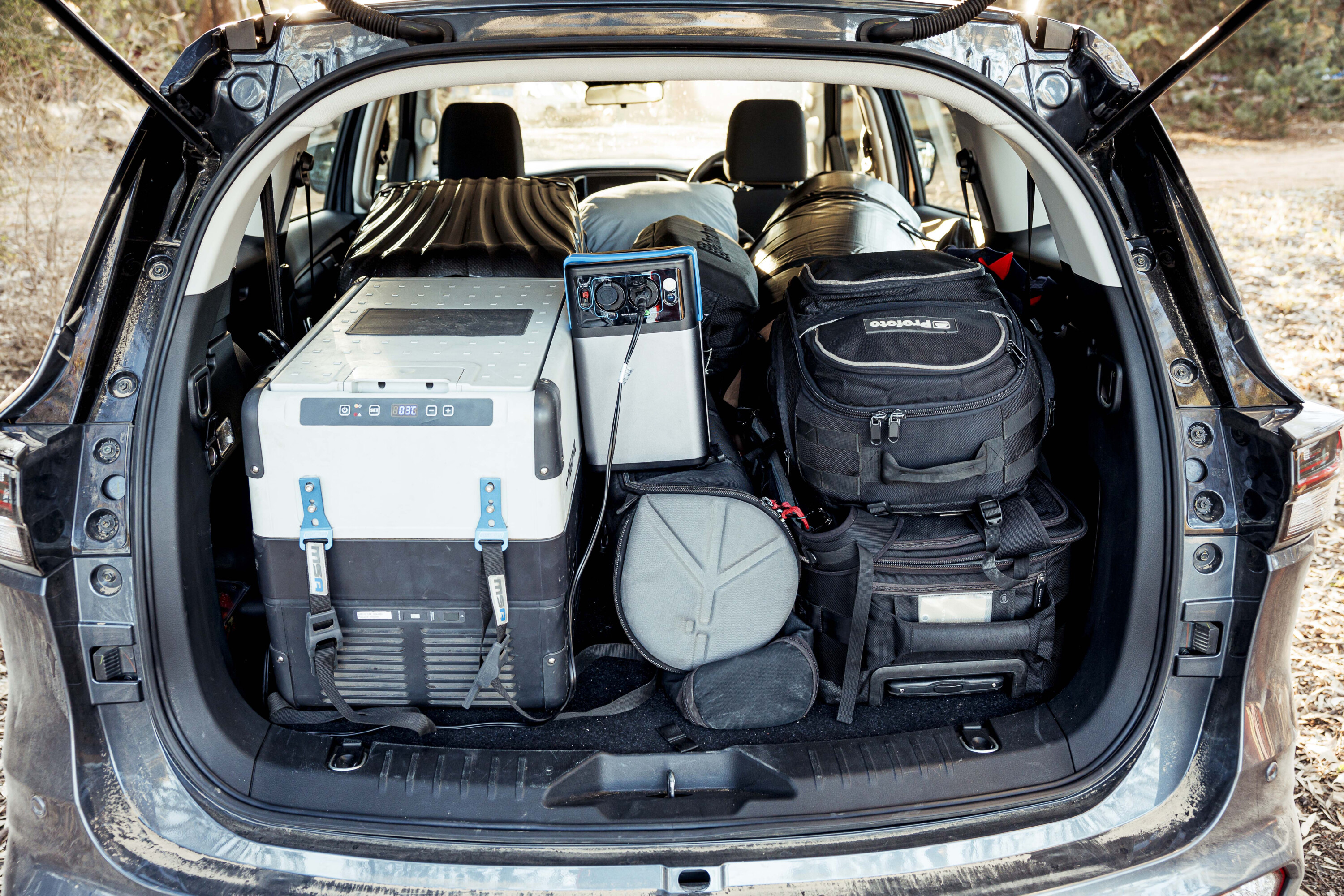
Last impressions
Whilst Isuzu‘s 4x4s muck about in a big pond of big competition, I found the MU-X was enjoyable to drive, a reliable workhorse, a spacious cabin to spend hours on the road, and user-friendly for my needs.
I loved the convenience of being able to Tetris a full load of “stuff” into the boot, from rocks for a little landscape gardening to several camping and work adventures. But also, the availability and capacity to take many friends comfortably and get on the road with ease.
All in all, the Isuzu leaves you knowing it can do a lot, and with competitive value.
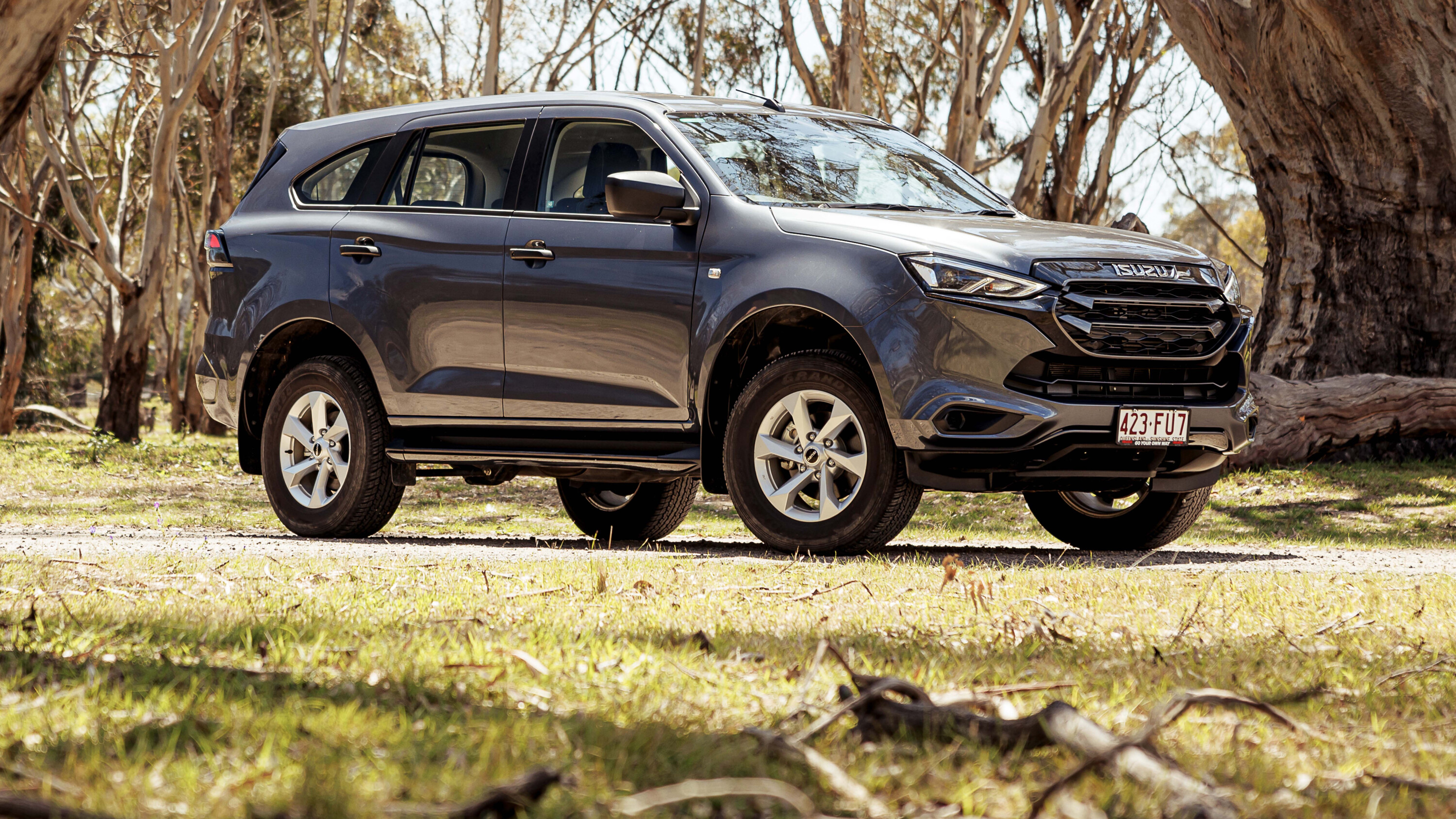
This is the 2025 BYD Shark plug-in hybrid ute!
Chinese carmaker BYD has unveiled its first ute, the Shark, in Mexico ahead of its Australian launch to rival the Ford Ranger, Toyota HiLux, Isuzu D-Max and Mitsubishi Triton.
With local arrivals due late in 2024 or at the start of 2025, the Shark will beat the Ford Ranger PHEV to market as the first plug-in hybrid ute sold in Australia – joining other ‘green’ models like the LDV eT60 EV and petrol-electric GWM Cannon Alpha hybrid.
While the best-selling utes in Australia have pure diesel or petrol power, the BYD Shark has a ‘Dual Mode Off-Road’ plug-in hybrid system, pairing a 1.5-litre four-cylinder turbo-petrol and dual electric motors for a combined power output higher than a Ford Ranger Raptor.
BYD claims the Shark has “more than” 321kW in total – compared to 292kW for the Raptor – with a 5.7-second 0-100km/h acceleration time.
Fuel consumption is rated at 7.5L/100km in Mexico, similar to other four-cylinder turbo-diesel utes sold in Australia, but higher than lighter and more-aerodynamic plug-in hybrid SUVs and passenger cars.
Braked towing capacity is rated at 2.5 tonnes – lower than most rivals that offer between 3.0 and 3.5 tonnes, including the Ranger PHEV – while its payload is listed at 835 kilograms.
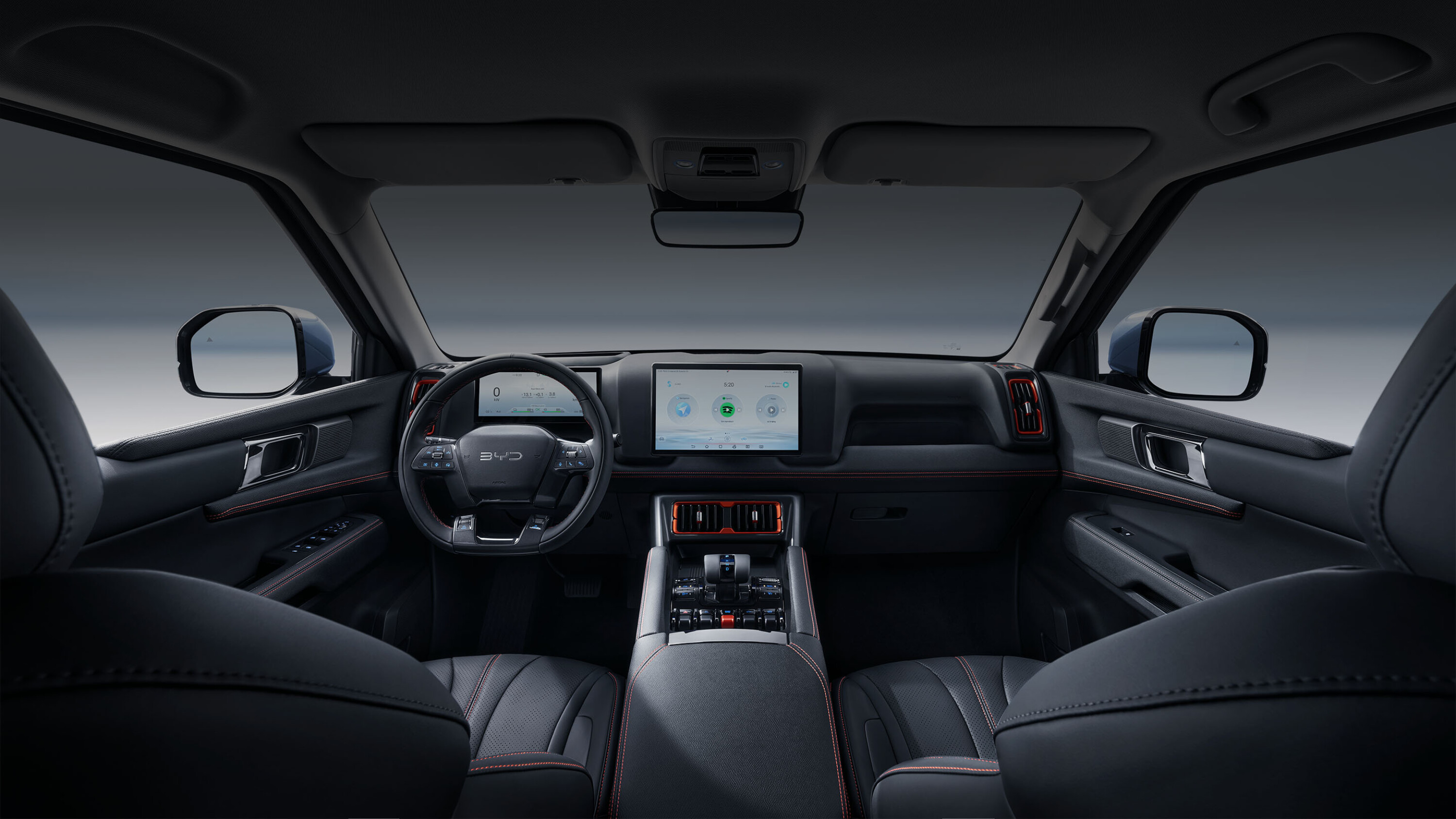
The combined driving range when the Shark is running as a hybrid is listed at 840 kilometres under the less-stringent NEDC testing cycle, while it has a 100-kilometre NEDC range in electric-only mode.
BYD says the plug-in hybrid system will prioritise electric motor propulsion for “up to 80% of total journeys” and it will also offer a vehicle-to-load function to power appliances from the vehicle’s battery. The lithium-iron phosphate ‘blade’ battery forms part of the chassis with structural rigidity of up to 38 per cent.
It has three terrain modes – sand, mud and snow – and instant torque distribution between the front and rear wheels, while there is independent coil-spring rear suspension.
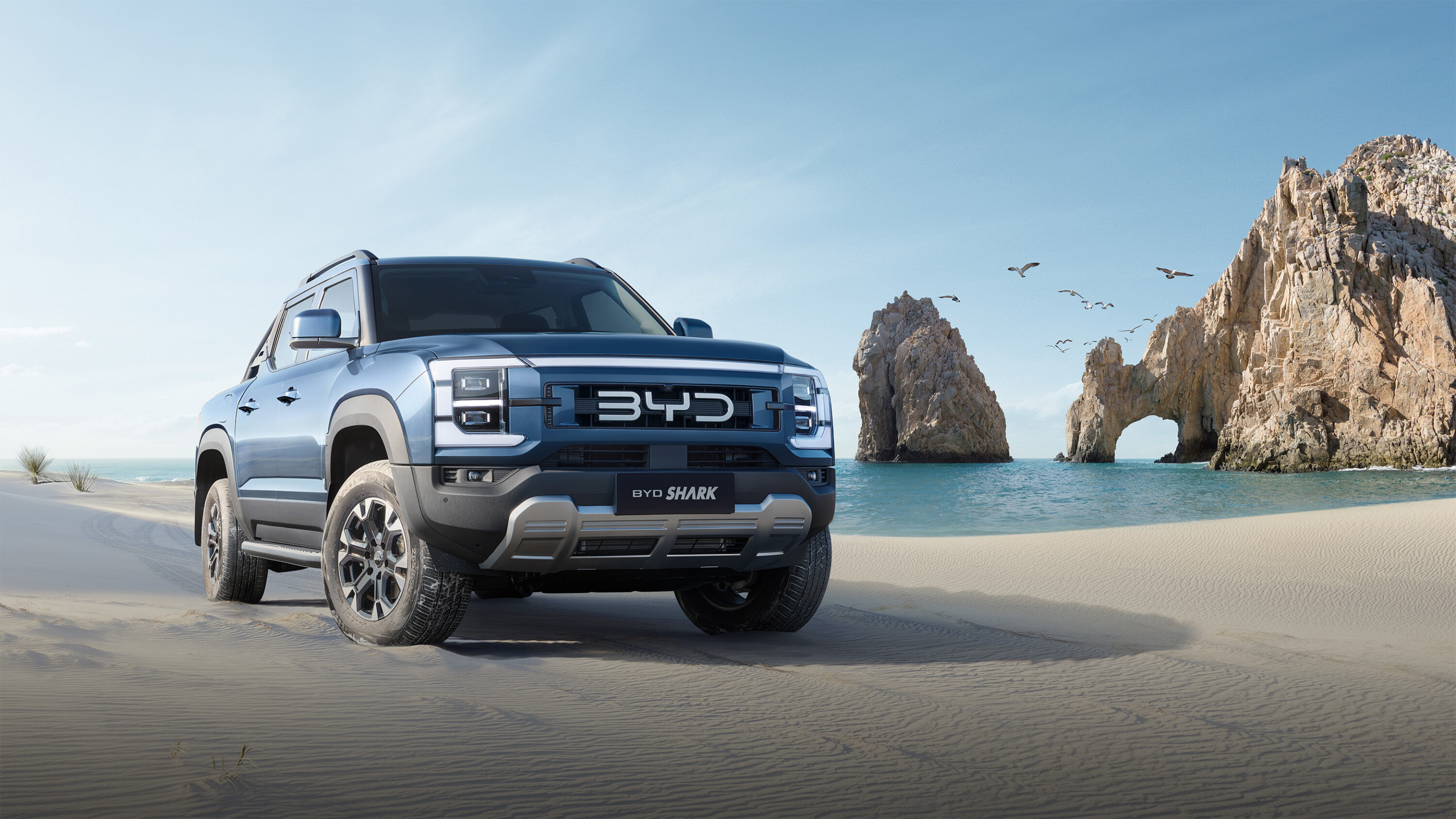
Measuring 5457mm long, 1971mm wide and 1925mm tall, the BYD Shark is one of the largest utes in the midsize class. For context, the Shark is 87mm longer, 53mm wider and 39mm taller than a Ranger Wildtrak.
Inside, the BYD Shark features a 12.8-inch infotainment system, Apple CarPlay and Android Auto, a 10.25-inch digital instrument cluster, a 360-degree camera system, a wireless phone charger, and a head-up display.
An NFC key card is also included, with iPhone users able to unlock, lock and start their Shark using the Apple CarKey function first seen in BMW vehicles. It is unclear if this functionality will be offered in Australia.
Mexican versions of the Shark have six airbags where less-stringent safety standard apply. Local versions could add a front-centre airbag for a better chance of receiving a five-star ANCAP safety rating.
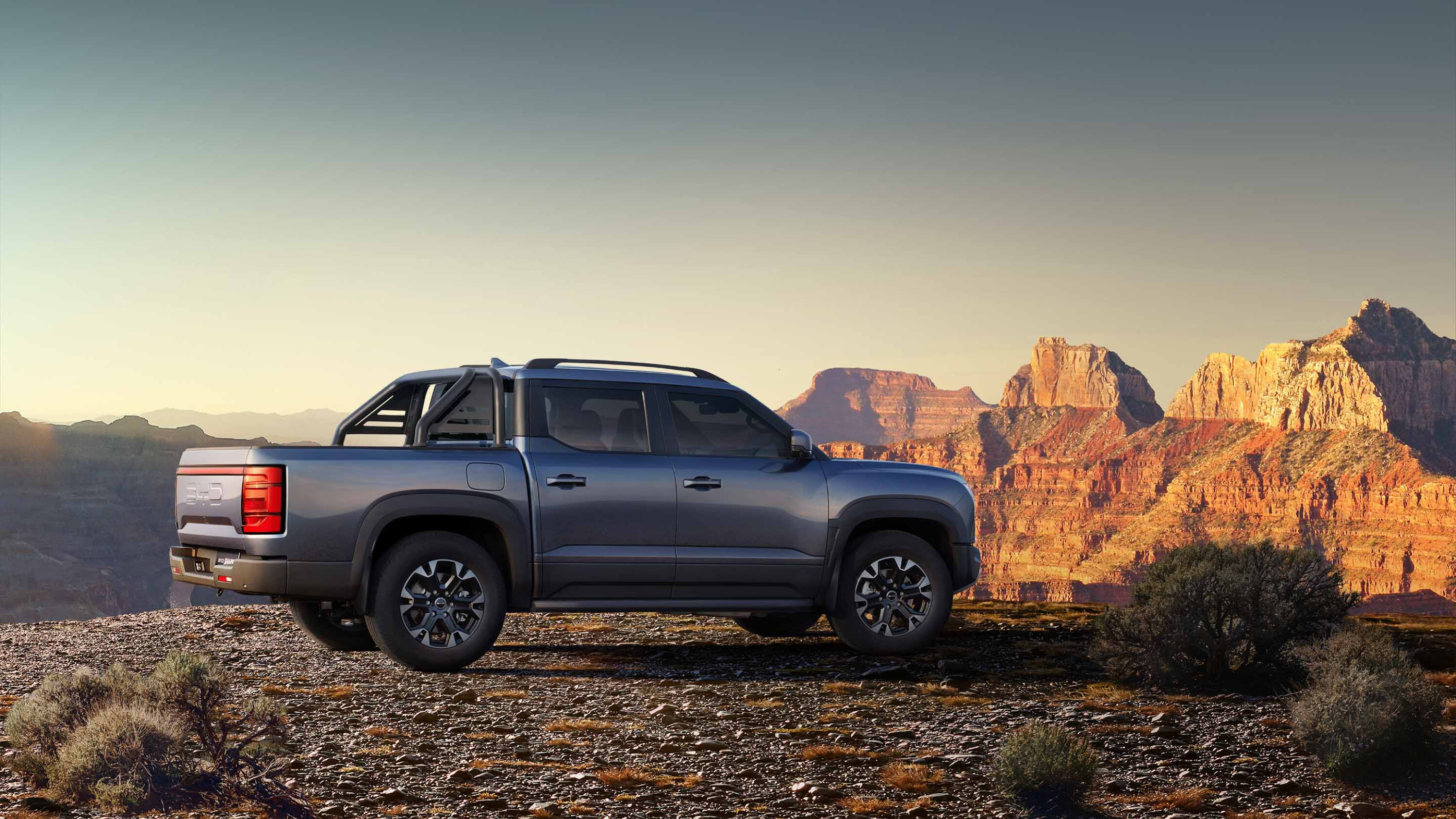
Active safety features include autonomous emergency braking, lane-keep assist, lane departure warning, blind-spot monitoring, rear-cross traffic alert, and adaptive cruise control.
In Mexico, the BYD Shark is priced from 899,980 pesos (AU$80,500), but local pricing should start closer to $70,000 before on-road costs – similar to the diesel Ford Ranger Wildtrak, Toyota HiLux GR Sport and Isuzu D-Max X-Terrain utes.
BYD has conducted local testing for the Shark – with prototypes spotted here since late 2023 – and it is likely to become one of the brand’s most important products in its ambitious goal to overtake Toyota and become the number one carmaker in Australia by 2030.
Keep up to date with all of our BYD Shark coverage at the links below.
The GLX is the working-class base grade in the new four-model Triton line-up, but the GLX+ pretties it up a bit by replacing the standard steel wheels with alloys, and adding side steps, rear privacy glass, front fog lights and some silver stitching to jazz up the plain cloth interior trim. Mechanically, it adds a differential lock to the rear axle.
Even at this level, the Triton gets the nine-inch multimedia screen in the centre stack and seven-inch info panel in-between the gauges in the dash binnacle. The interior is a big step up from the previous model as it’s bigger, more spacious, more modern and is particularly well laid-out.
The multimedia screen is placed high on the centre stack where your eyes easily find it, and it is easy to use. The screen includes phone mirroring with wireless Apple CarPlay, Android Auto, inbuilt sat-navigation and two USB inputs. Another two USB outlets at the back of the console for rear seat occupants come with the GLX+ but are missing on the regular GLX.
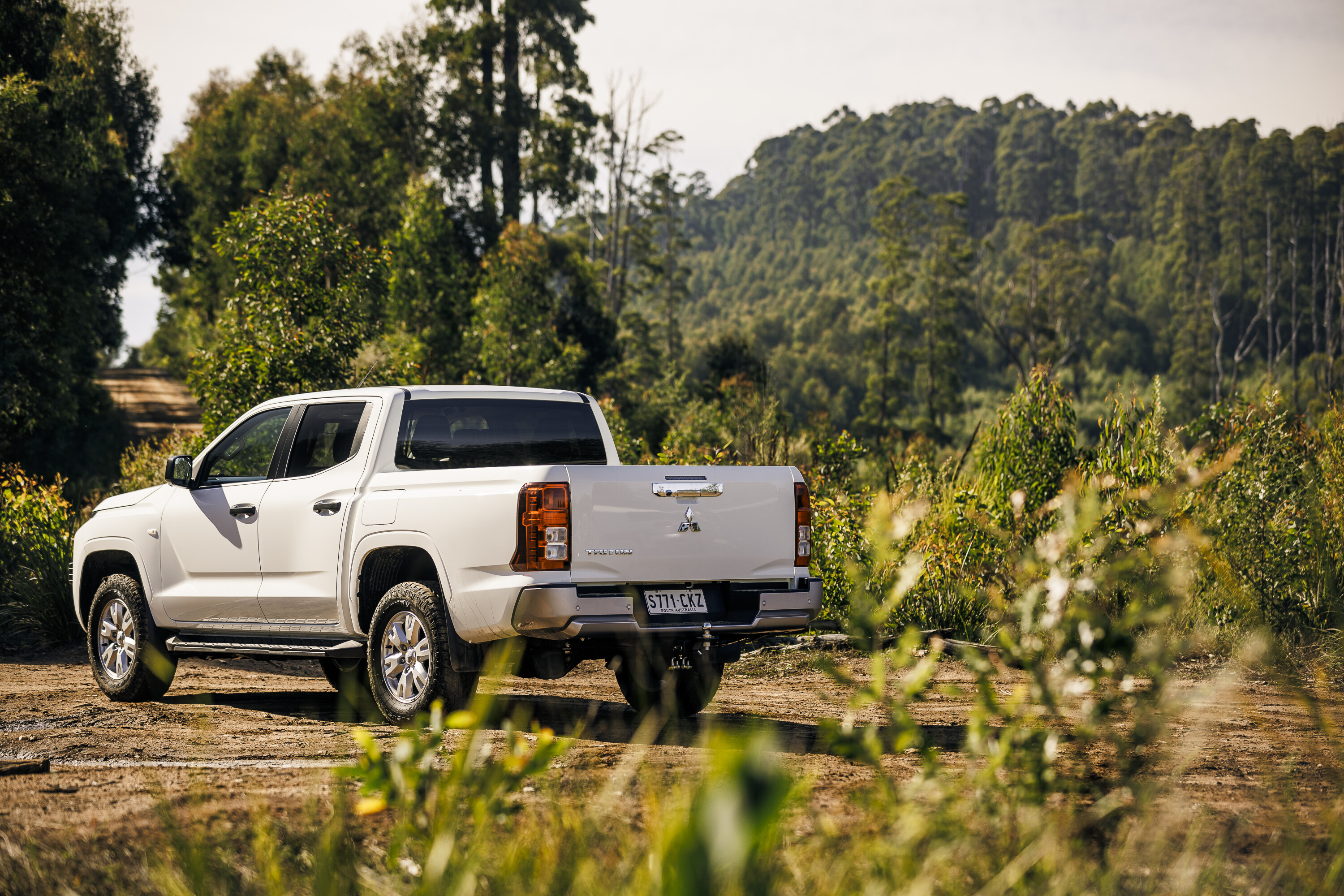
The screen has user-friendly dials for volume and track selection control, with large buttons below the central vents to control the climate system. You’ll need to press a button on the key fob to unlock the doors, and then put the key in the ignition to start the engine – plus there’s a good, old handbrake lever to release before you can move away. The GLX+ is an honest workhorse with everything you need and nothing you really don’t.
Like the cabin, the cargo tub of the new Triton has grown and is now similar in size to most of its competitors, even larger than some. In this trim the rear compartment is fairly spartan, with tie-down points down low in the rear corners where they are most useful, but also up higher in the front where they are less than ideal. The tray in the GLX+ has no lighting, power outlet or protective liner.
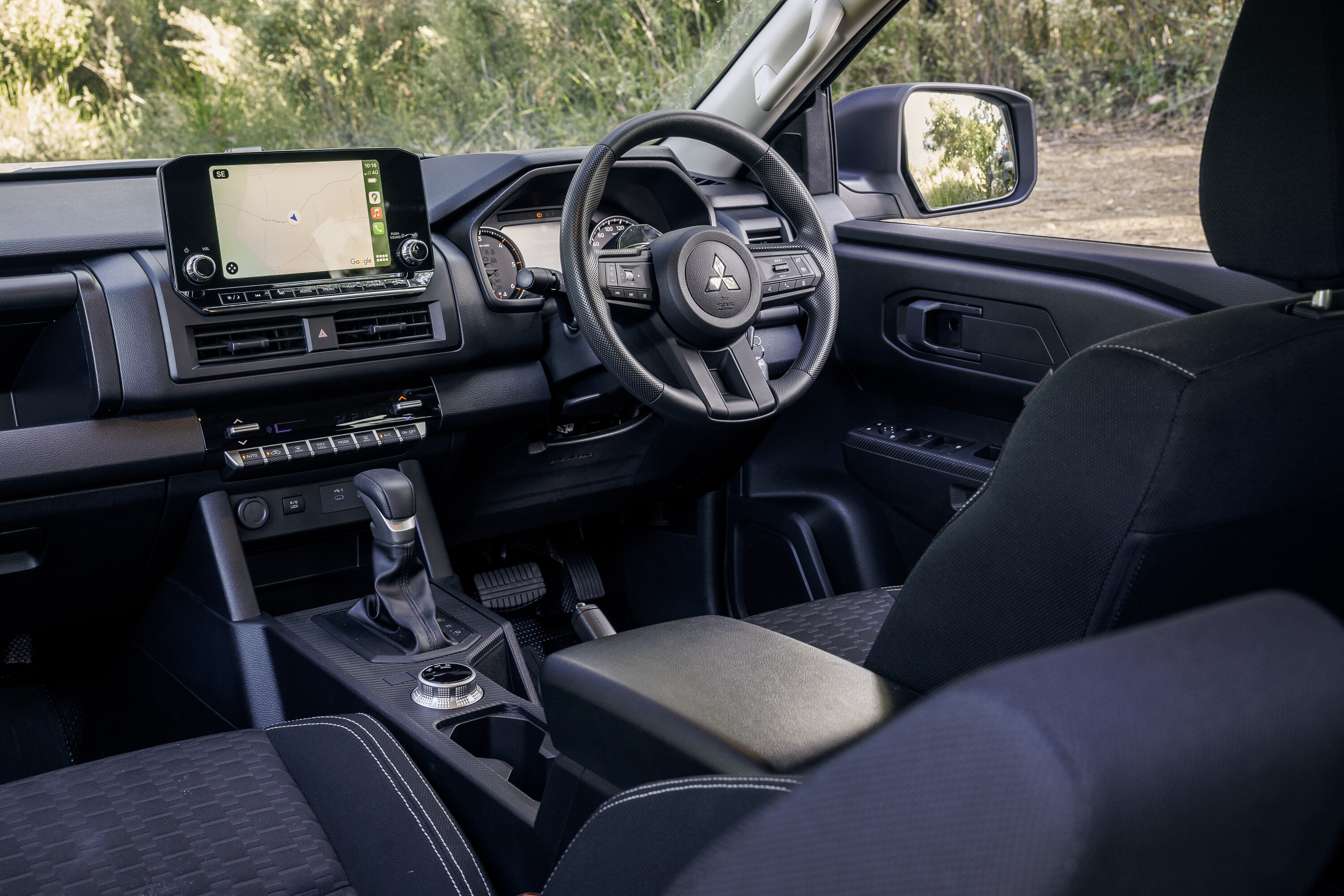
The GLX and GLX+ models get a heavy duty leaf pack in the rear suspension for better load-carrying, while the models above them get a softer leaf pack for more comfort. The GLX+ comes wearing Toyo all-terrain tyres. This could be the perfect specification on which to build your Triton tourer, with a service body on the back.
All new Triton 4x4s are powered by a 2.4-litre diesel engine which now uses a pair of turbochargers to increase outputs to 150kW and 470Nm, bringing it closer to the class leaders if not matching their 500Nm peaks. It’s enough to make the Trion get along nicely, with swift acceleration and pulling power.
While four-cylinder diesel engines are never really quiet and refined, we did find the Mitsubishi engine to be a bit raucous when compared to some of its competitors with similar engines. This harshness is amplified with the automatic stop/start system that is particularly rough and will have the driver quickly looking for the button that turns the system off. We expect the aftermarket will release a mod that permanently disables stop/start in the Triton as it has for other vehicles, and it will be welcomed by new Triton owners.
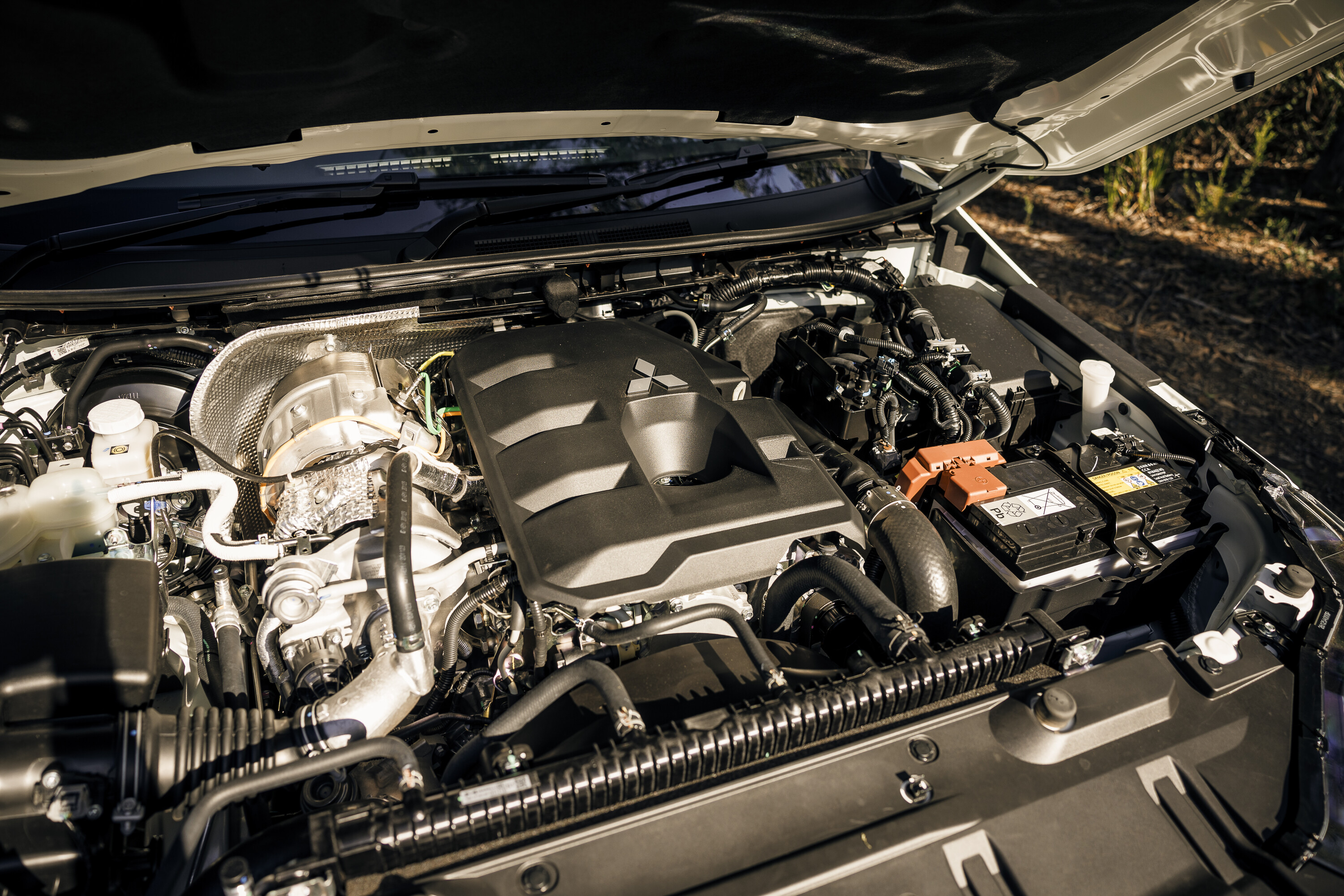
The Triton’s six-speed automatic transmission can feel a bit aggressive in its shift patterns, particularly its keenness to downshift on deceleration which is really noticeable – it’s like the transmission is in a sport mode when you really don’t want it to be. It does its job well but it’s a bit too aggressive at times.
The GLX makes do with a part-time dual-range 4×4 system, and you have to step up to a GLS or GSR grade if you want Mitsubishi’s Super Select II which adds full-time 4×4 to the transfer case. Some might see this as essential and it is a handy feature to have, but it’s certainly not a deal breaker. There’s nothing wrong with the part-time system and we found it quick to engage both low range and the rear differential lock. You can shift the transfer case from 2WD to 4×4 high on the move when you hit the unsealed roads, as we did on the forest tracks. The electronic traction control was sufficient for most of our travels and it worked well when crossing rutted tracks where tyres lost traction.
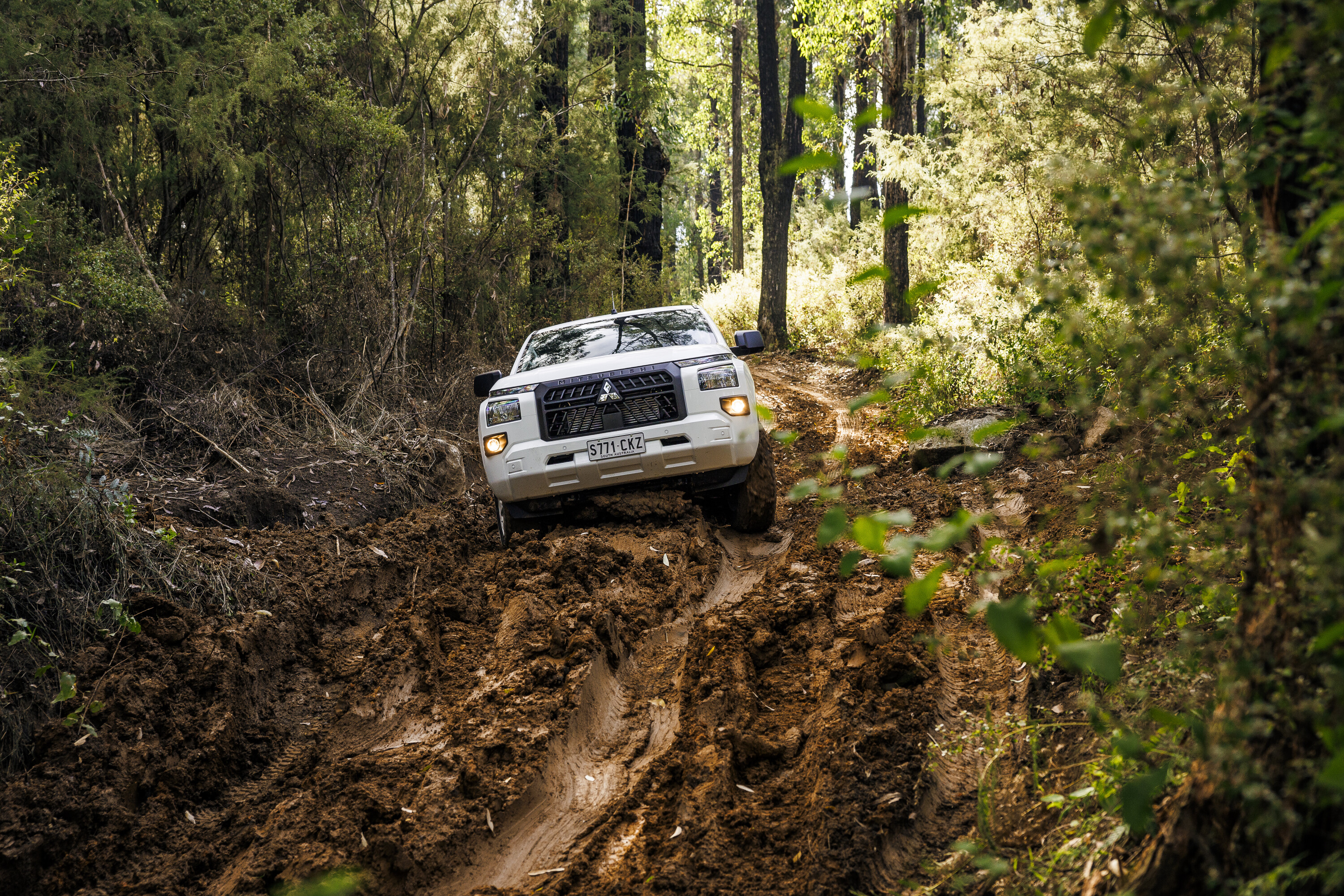
The new Triton has achieved a five-star ANCAP safety rating and is the first and only 4×4 ute to get this under the latest 2024 standards. The safety package includes all the regular technologies such as AEB, ABS, ESC, ETC, lane departure warning and intervention, and rear cross traffic alert. It has nine airbags. However, the GLX+ misses out on the Tyre Pressure Monitoring System (TPMS) and front cross traffic alert system that is included with GLS and GSR variants.
A new feature is the driver monitor, which beeps if you block its view of your face with your hand on the top of the steering wheel, or if you’re looking to the centre stack/screen to adjust the settings, temperature or music. Some drivers have said they found this a constant annoyance, but it’s not as intrusive or annoying as other driver monitors I’ve experienced. That said, I still have a problem with having a camera pointed at my face whenever I am driving, and unfortunately this style of camera will become more prevalent in new cars for manufacturers to get the maximum safety rating.
The size and comfort of the new Triton will put it back on the radar of any 4×4 ute buyers, and deservedly so. It’s a better car to drive, and the bigger interior is so much more functional and user-friendly. As a GLX, it’s a no-frills car that still has all of the essentials you want in a ute.
There was a time not that long ago when the Triton was a lock as the third best-selling 4×4 ute in the country. That position has been lost to the Isuzu D-MAX, and with more new metal coming in 2025 in the form of the Kia Tasman and new Nissan Navara, the battle for sales is sure to heat up.
Specs
| 2024 Mitsubishi Triton GLX+ | |
|---|---|
| Price | $53,290 +ORC |
| Engine | Inline 4-cyl diesel, twin turbocharger |
| Capacity | 2442cc |
| Max power | 150kW@3500rpm |
| Max torque | 470Nm @1500-2750rpm |
| Transmission | 6-speed auto |
| 4×4 system | Part-time, dual range 4×4 |
| Crawl ratio | 39.46:1 |
| Construction | Inline 4-cyl diesel, twin turbocharger |
| Front suspension | IFS with wishbones and coils |
| Rear suspension | Live axle on leaf springs |
| Tyres | 265/65-17 alloy wheels |
| Weight | 2105kg (kerb) |
| GVM | 3200kg |
| GCM | 6250kg |
| Towing capacity | 3500kg |
| Payload | 1095kg |
| Seats | 5 |
| Fuel tank | 75Lu00a0(17L adblue) |
| ADR fuel consumption | 7.5L/100km |
| On-test fuel consumption | 9.6L/100km |
| Approach angle | 30.4u00b0 |
| Rampover angle | 23.4u00b0 |
| Departure angle | 22.8u00b0 |
| Ground clearance | 228mm |
I hadn’t seen this piece of gear until my son dropped it out of his truck at the end of another season of travels in the Outback with Moon Tours, throughout which he’d used it a few times to lift heavily loaded Cruisers and other 4x4s.
Over the next few days I had a play with the VEVOR pneumatic jack, lifting my heavily loaded Patrol, and I was impressed with its capability, speed and ease of use. The VEVOR is compact, measuring 300mm x 240mm x 450mm when in carrying mode, but it weighs in at a hefty 15.6kg, so it’s a bit heavier and bigger than a normal bottle jack.
Having said that, it has a large footprint which is great for stability and for lifting when on soft surfaces. Its lifting capacity is rated at three tonnes, which should be enough for a loaded Cruiser, Patrol or Grenadier. The depressed height is impressive at just 140mm, which means it can slip under an axle even when a tyre is dead flat and clearance is at a minimum. Fully extended height is a generous 450mm, making sure any tyre is lifted well off the ground.
Lifting is achieved by connecting an air compressor to the inlet of the jack. Meant mainly for a workshop environment and an industrial compressor, in an off-road situation, a 12-volt compressor really needs a 4-litre or larger air tank to work the jack correctly and efficiently.
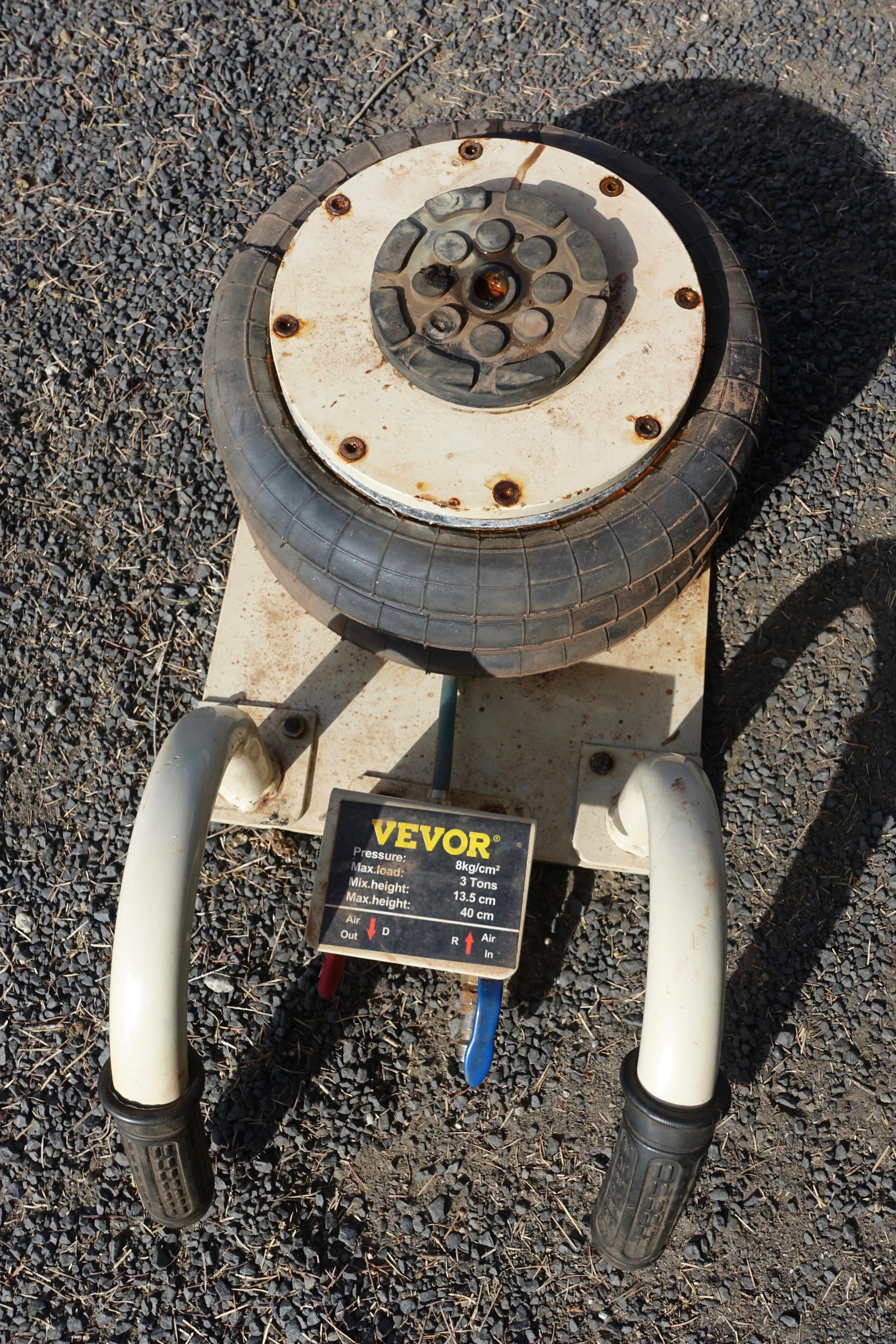
Once going, the air jack lifts smoothly and reliably and takes just a few seconds to lift the vehicle. This is achieved through the three-layer triple-bag design which utilises six internal steel pipes strategically optimised for height and structure to provide great stability. Lowering the jack is easy and can be steadily and quickly done to obtain the desired height.
The marketing blurb goes on about the durability of the unit and that it’s built to last, and the unit we have on test appears to be as tough as claimed. Mind you, the blurb also goes on about the longevity of the paintwork on the base, but as can be seen, ours is a bit scuffed, not that this has anything to do with the operation of the jack.
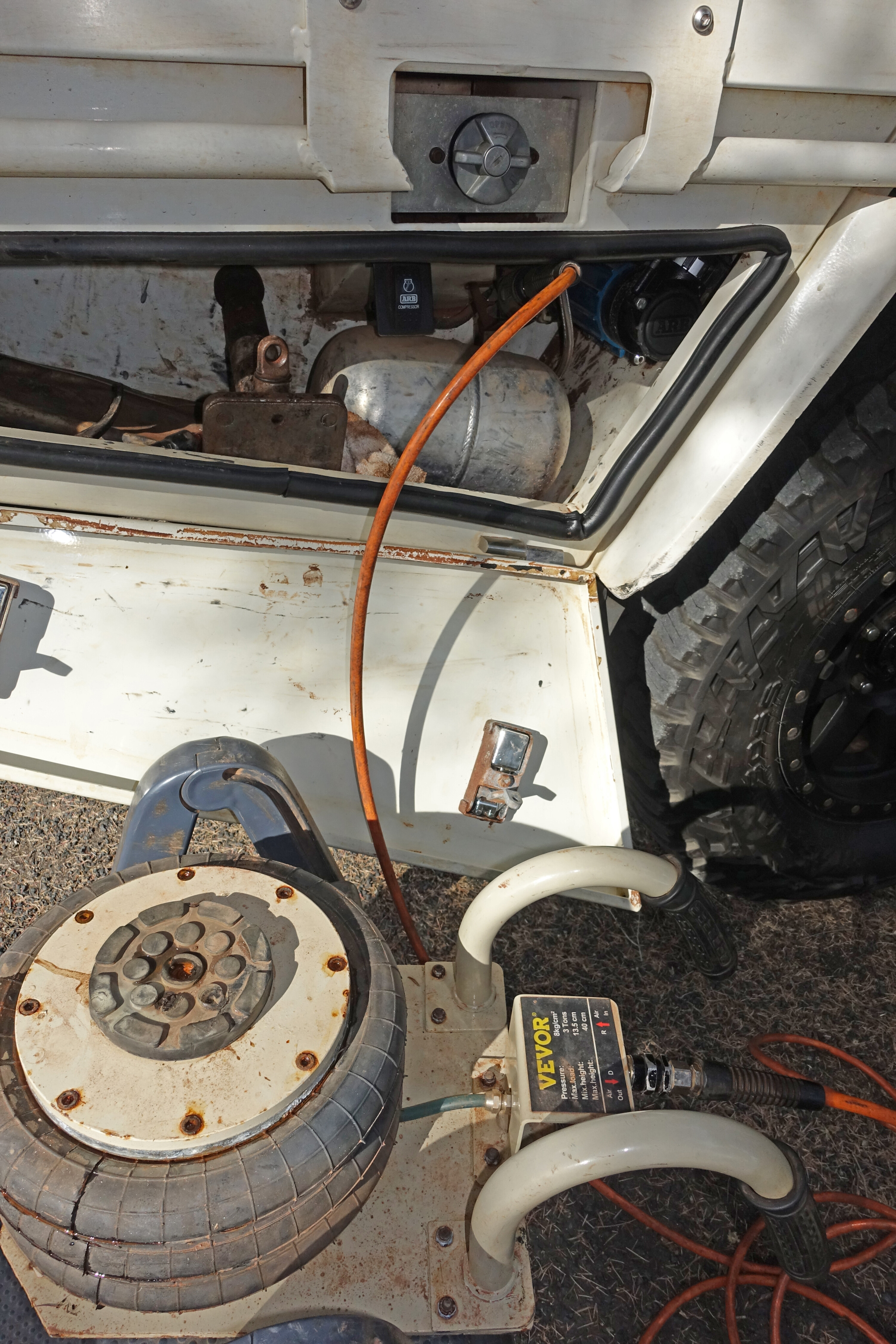
All in all though, we’re pretty impressed with the VEVOR, especially with its ease of use and its lifting ability. And, priced at under $160, it seems to be great value for money.
It is covered by a 12-month warranty and there are a few different models to choose from.
Pricing: RRP $159
MSA 4×4 Deluxe Coffee Kits
The Deluxe Coffee Kit is the perfect solution for the coffee lover who wants to enjoy a quality cup of coffee anytime and anywhere, whether at home, in the office or on the go.
The kit consists of a French press-style coffee plunger; two cups with a quality clear, rubber-sealed lid to prevent spillage; two sealable storage canisters to hold coffee, sugar or creamer; a coffee measuring spoon; two teaspoons; and a cleaning cloth.
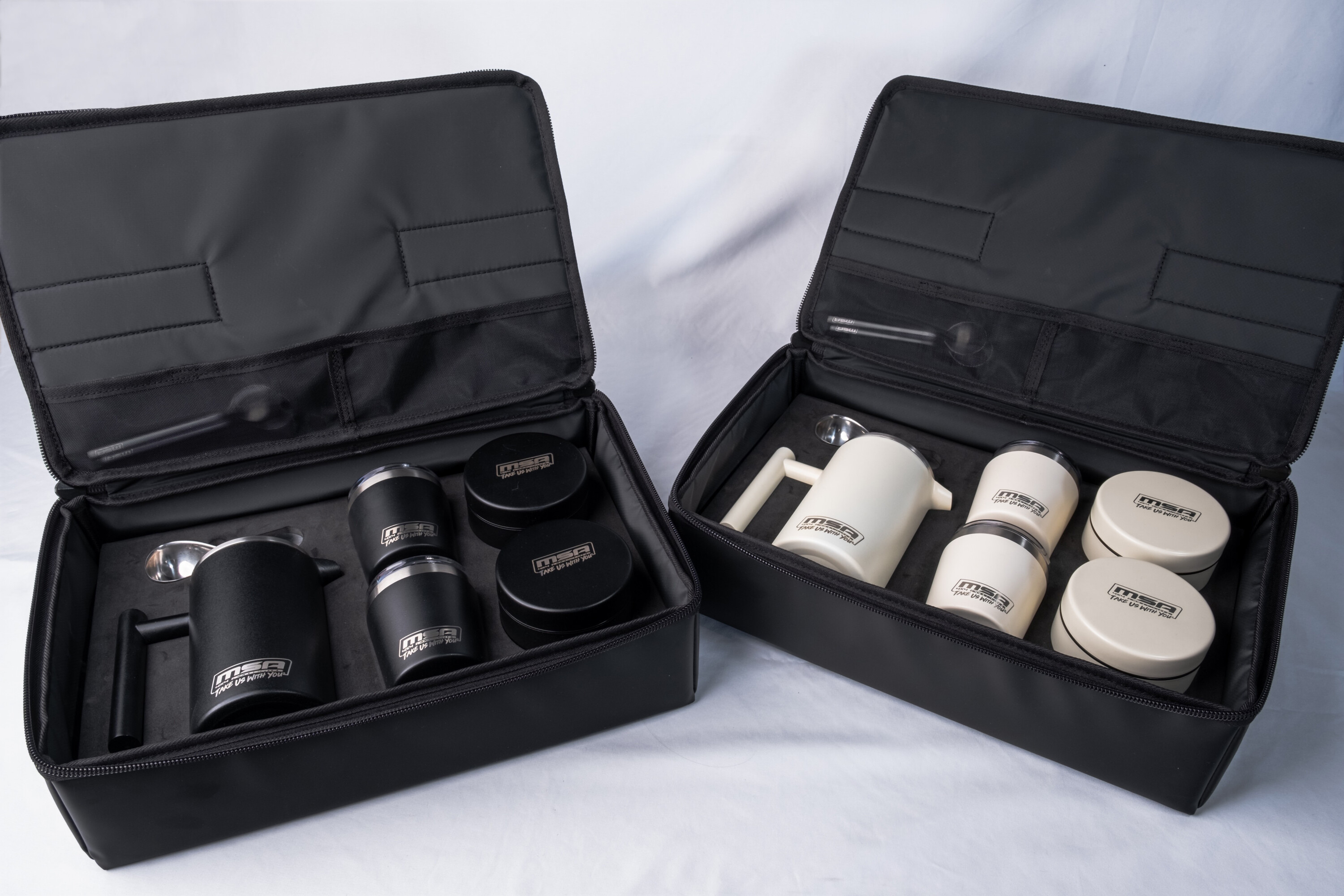
All components are presented in a stylish, spill and water-resistant storage bag. A versatile mesh pocket positioned on the underside of the lid creates an ideal place for the unique MSA 4×4 branded teaspoons and sugar sachets. The durable powder-coated stainless steel construction, with double-wall vacuum insulation, is designed to keep coffee or other drinks hot or cold.
The coffee plunger allows for a rich and flavourful brew by steeping the coffee grounds in hot water, resulting in a smooth and full-bodied coffee… anytime, anywhere.
RRP: From $230
MSA 4×4 Explorer Storage Bags
MSA 4×4 Explorer Storage Bags help you to organise and secure items and are designed to fit perfectly within the company’s storage drawers.
Available in three sizes, Explorer Storage Bags are made from a spill- and water-resistant satin black Hypalon exterior and a matching grey PVC interior, reinforced with high-density 4mm EVA foam sides and lid.
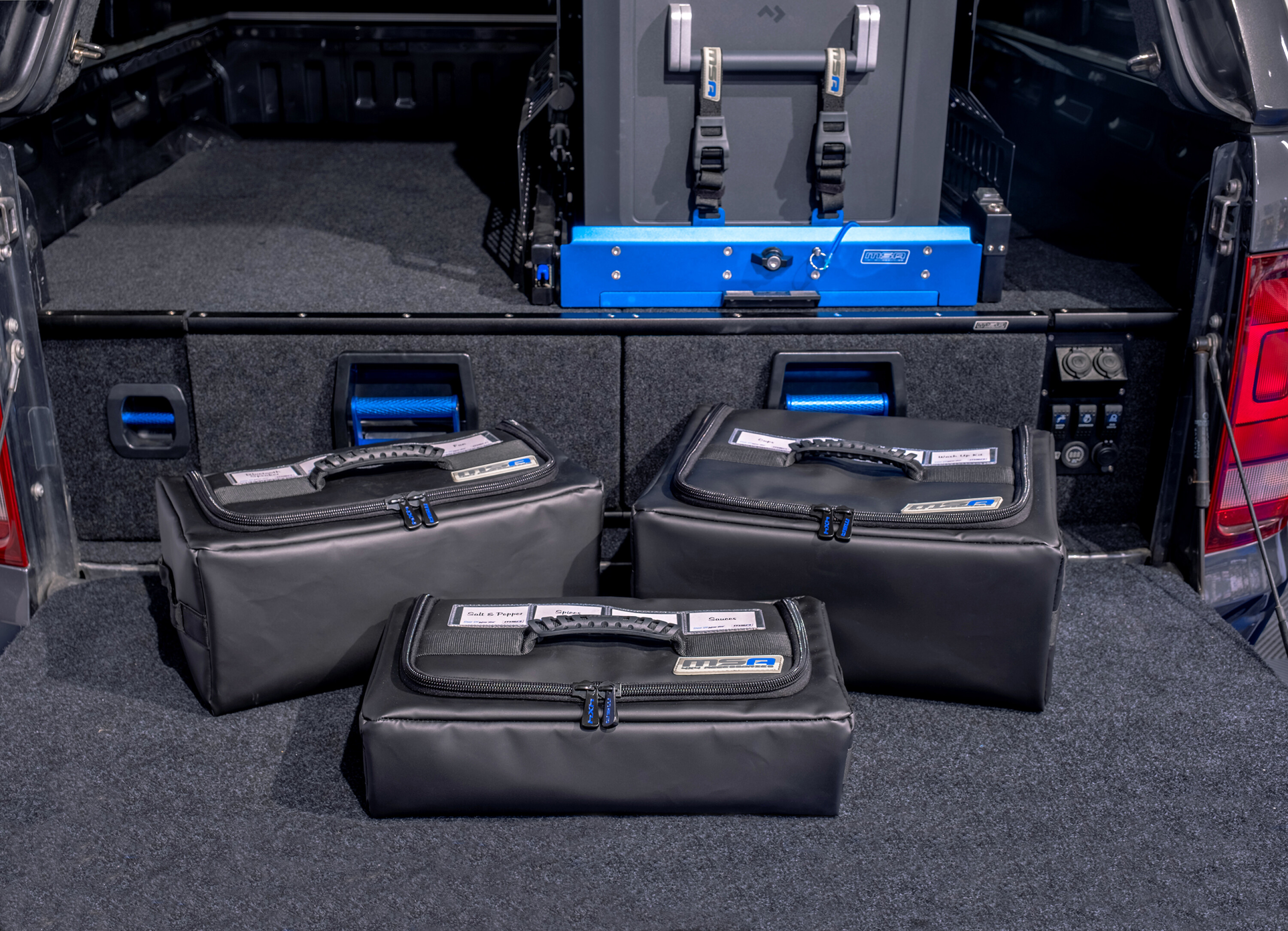
Secured with a chunky nylon zip, the bags feature a sturdy top carry handle and grab handles at each end to provide a comfortable means to manoeuvre the bags with heavier items inside. Four clear pockets on the lid, combined with supplied blank labels, allow for a highly visible labelling solution.
Each bag comes with at least two bag dividers, creating segmenting options, and these can be configured easily thanks to Velcro connection. There’s a mesh pocket on the full-height half-bag divider, providing an additional storage option.
Whether buying as a one-off or in a combination of sizes, the MSA 4×4 Explorer Storage Bags fit snugly together within an MSA 4×4 Storage Drawer System.
RRP
- Small: $100 (small)
- Medium: $110 (medium)
- Large: $120
- Bundle (1 large, 1 medium and 1 small): $300